Nigeria, it seems, was the last of the "strange" places on our trajectory, and before we knew we found ourselves back in the countries that tourists, too, visit. Although Togo and Benin are not paricularly well known in the world, we were shocked by the numbers of white people we saw after a while "off the radar", so there must be something that attracts them.
It must be voodoo. Reportedly it is from here that this religion was spread around the world, exported by the slaves to Brazil, Cuba and elsewhere. Today, in West Africa alone, tens of millions of people follow this seemingly weird religion that was founded here together with the famous kingdom of Abomey that existed from 1625 to 1892. It is not all about spells and human sacrifice, of course, but it does have some elements that would make us scorch our noses. Such as the use of fetishes - live or dead objects that are believed to have divine power and that are used in religious ceremonies and in everyday life to gain strength or protection against something, for example. While in Abomey, capital of the ancient kingdom, we went to see a fetish market where all sorts of dead birds and animals and their skulls were for sale, as well as some live specimen.
...::: LISTEN music from Benin I :::...
...::: LISTEN music from Benin II :::...
...::: LISTEN music from Benin III :::...
...::: LISTEN music from Benin IV :::...
...::: LISTEN music from Benin V :::...
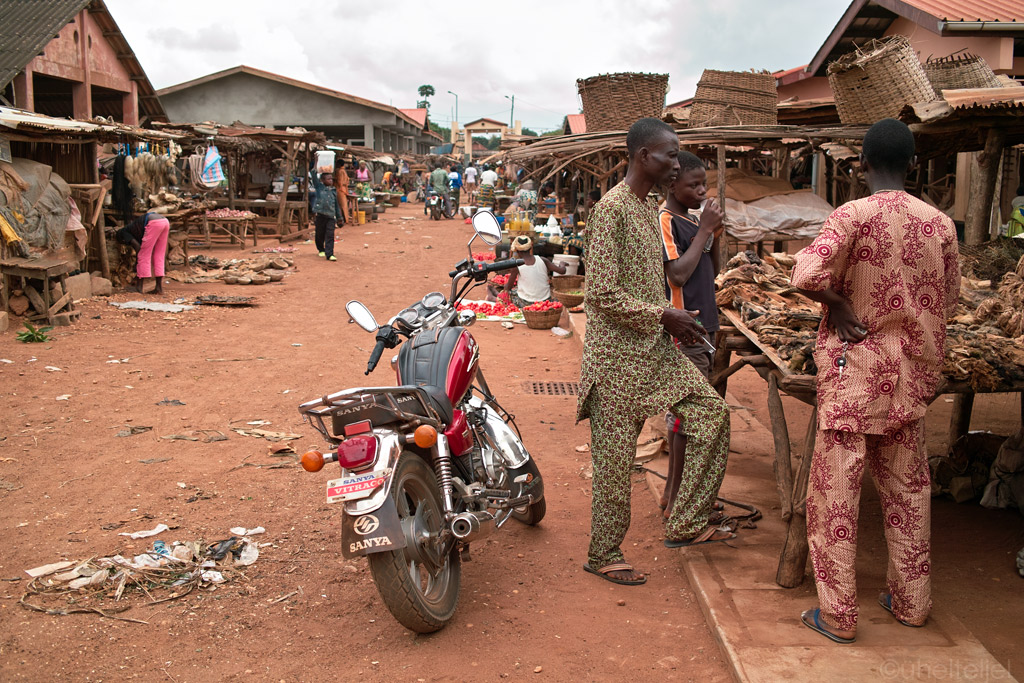
Shopping for fetishes.
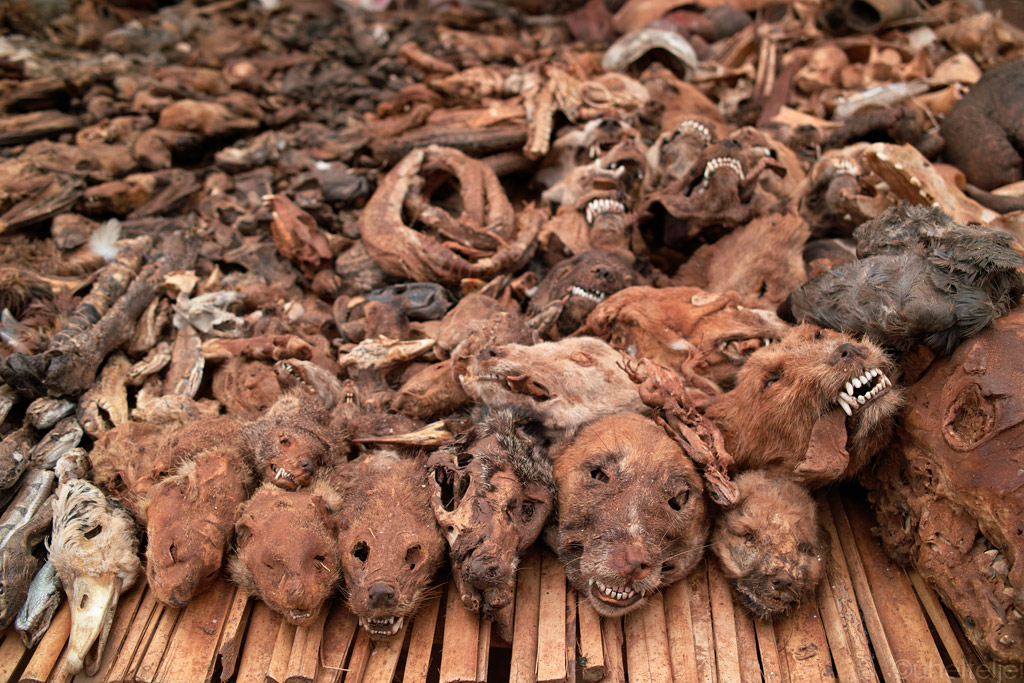
Fetishes for sale.
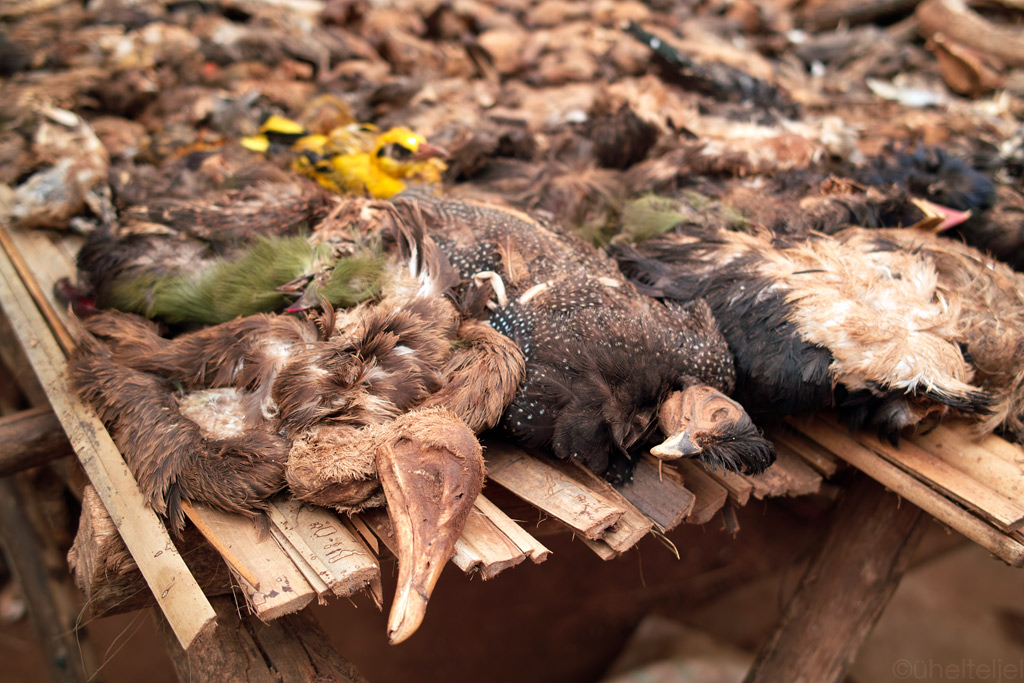
Birds are supposed to bring happiness.
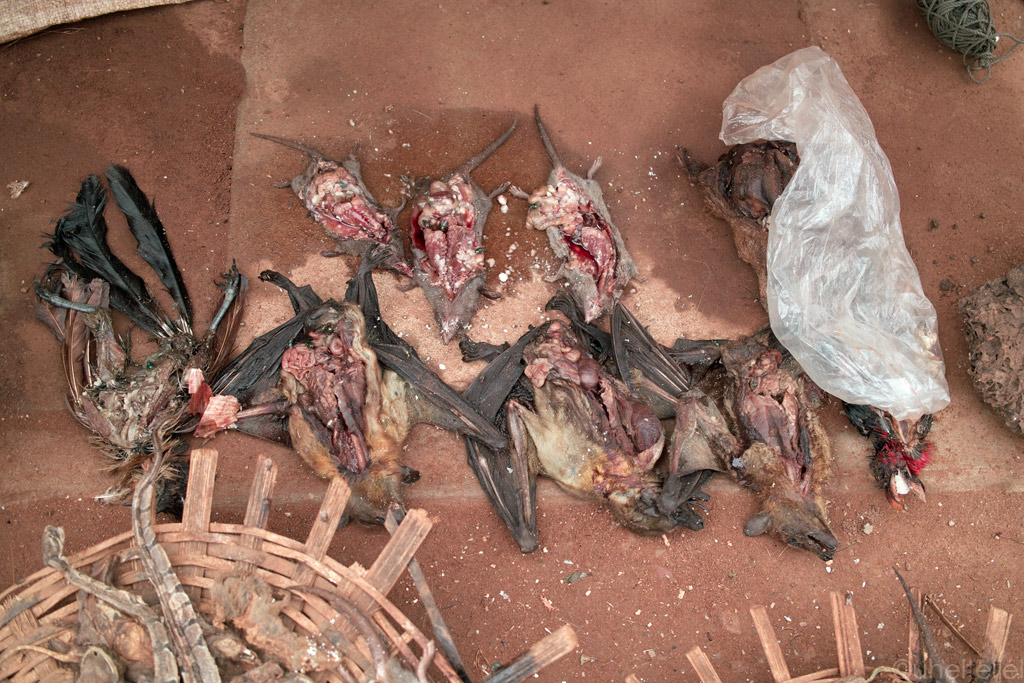
Bisected rats and bats.
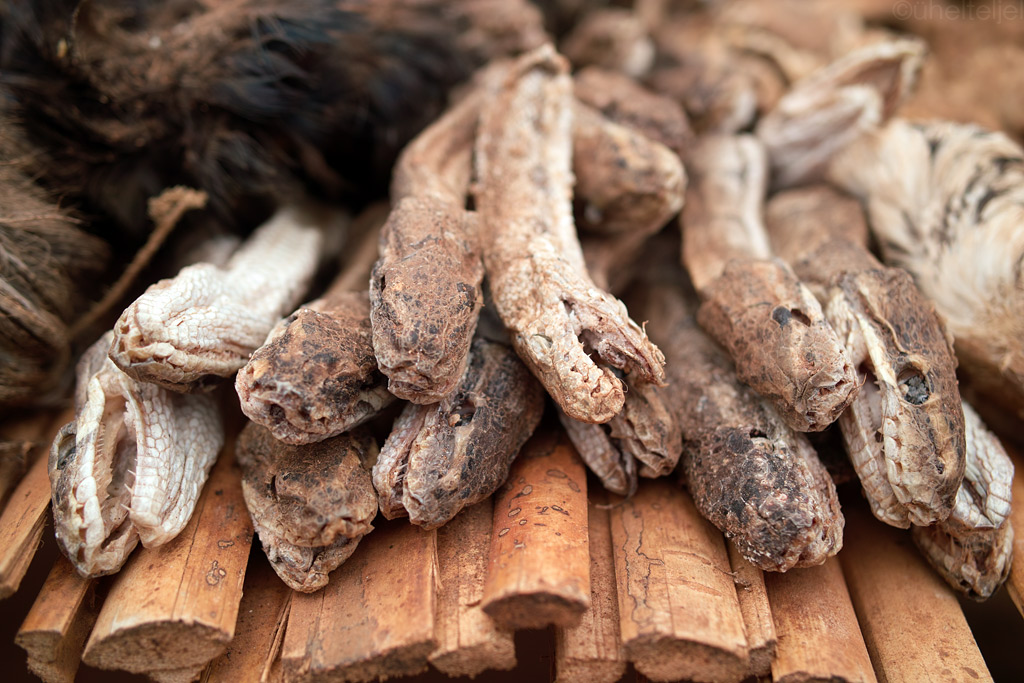
Snakes work for protection.
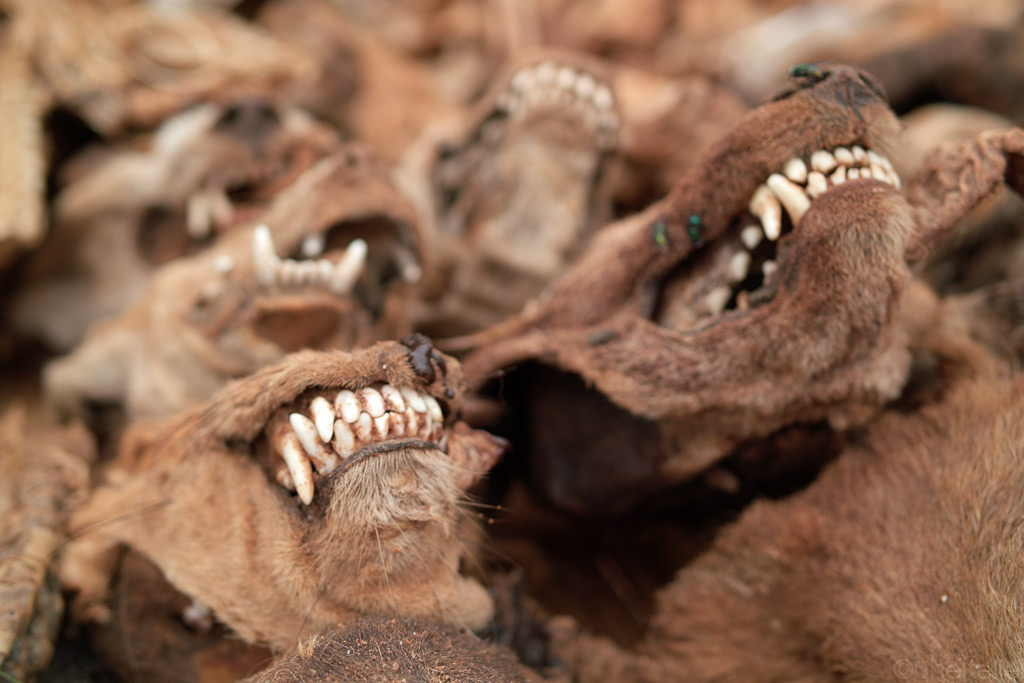
Predators.
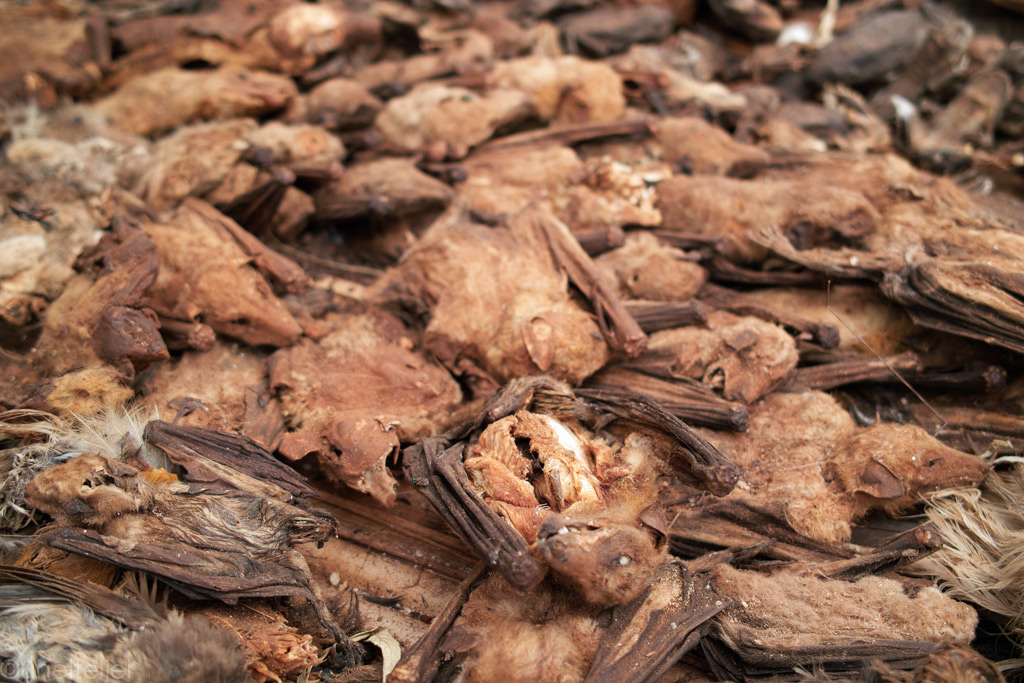
Bats.
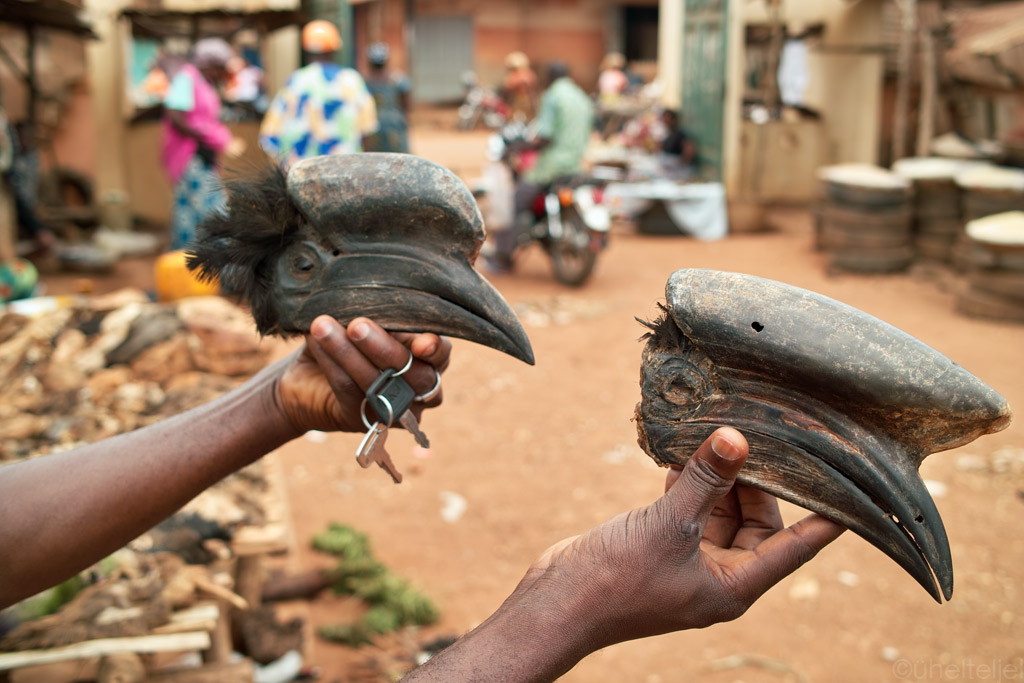
Toucan heads are hard to come by.
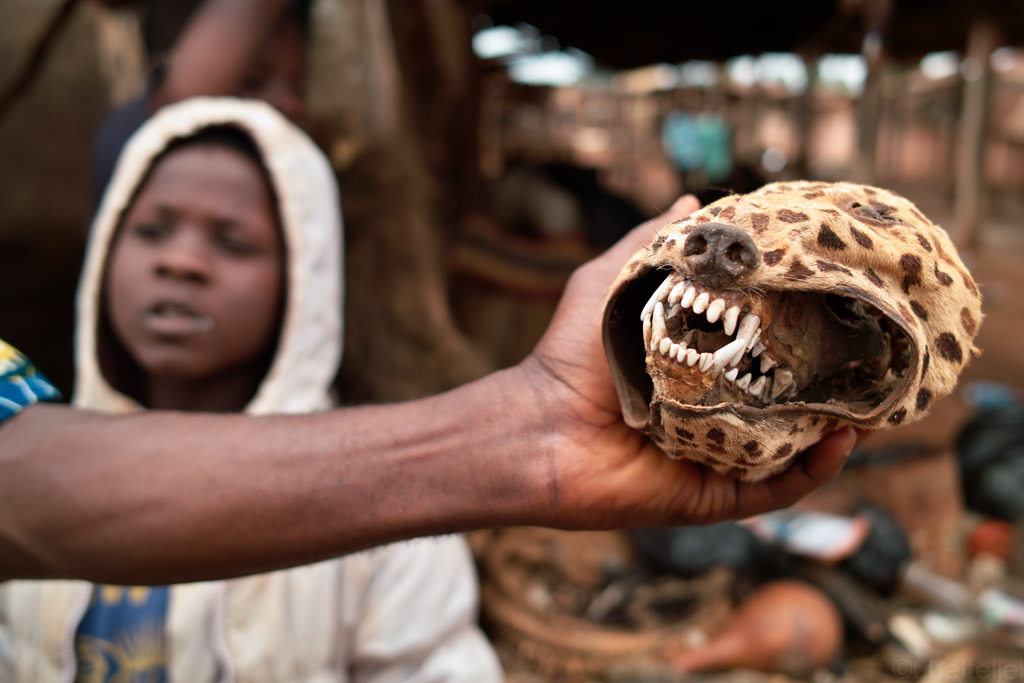
Leopard is one of the more powerful fetishes you can find.
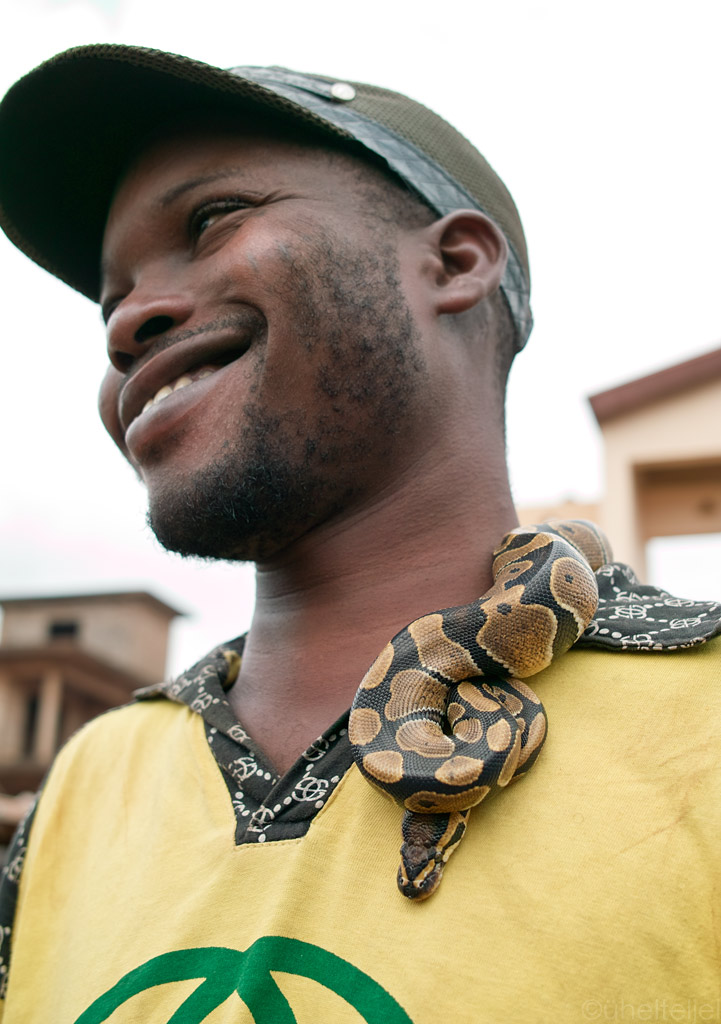
Fetish seller with a live baby python - we could have bought it for 1 USD.
Also statues play an important role in voodoo religion, and we even saw one in the making - it is supposed to take one month to complete.
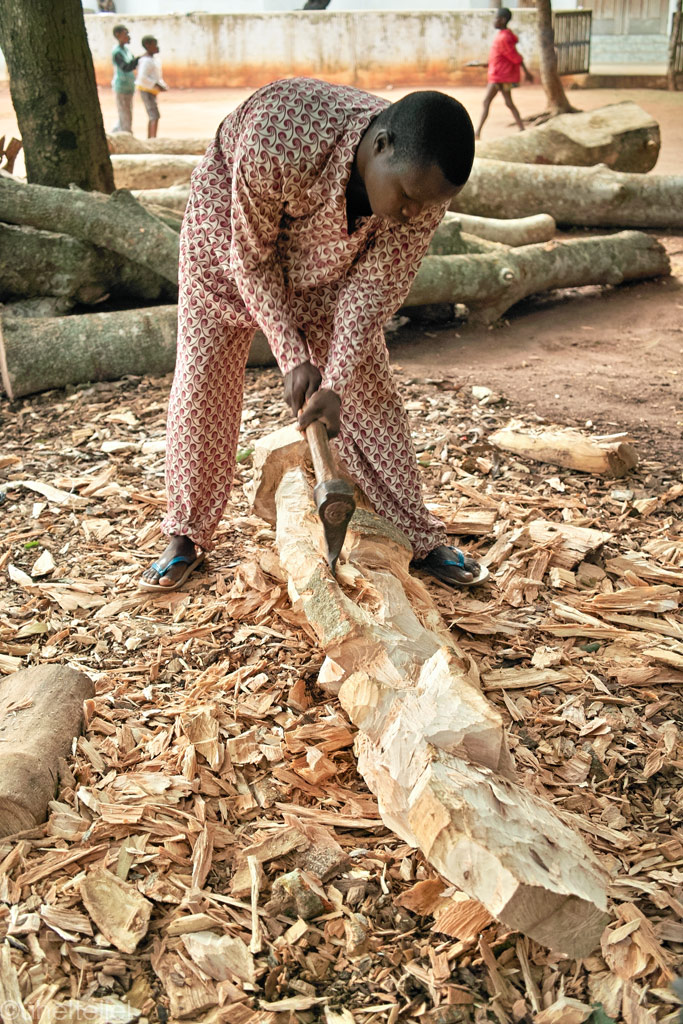
Still a long way to go.
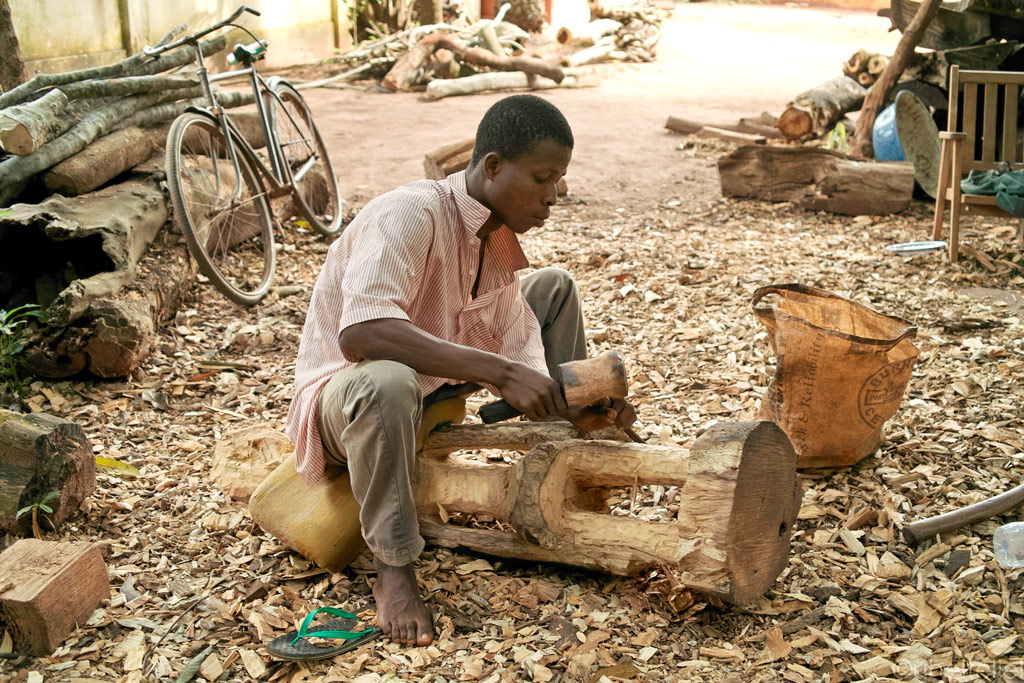
More like it.
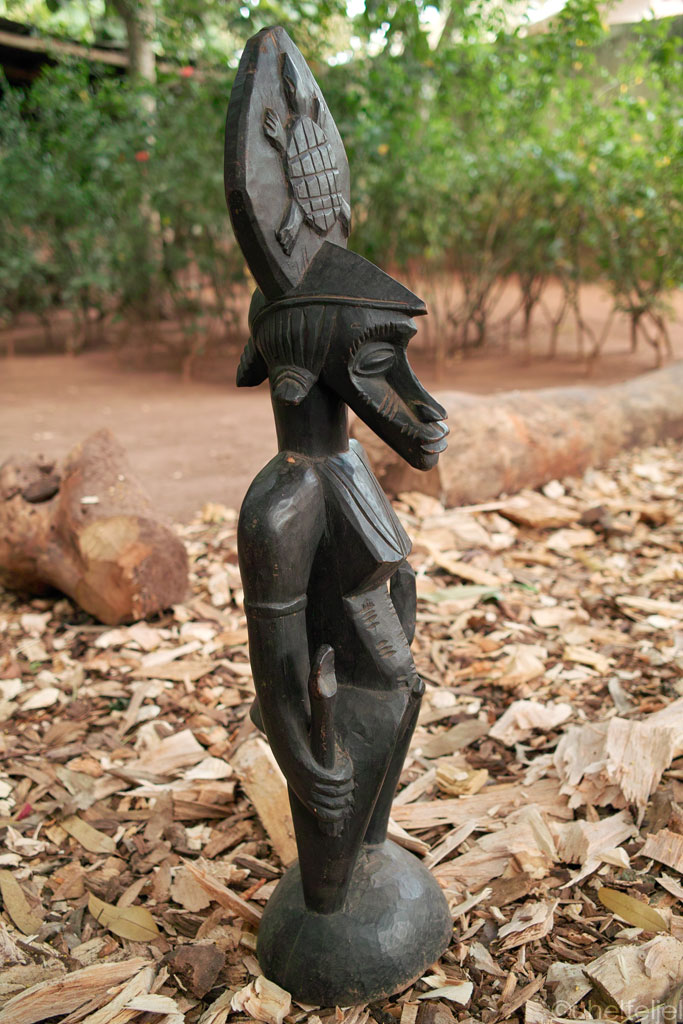
This is what it whould look like when finished.
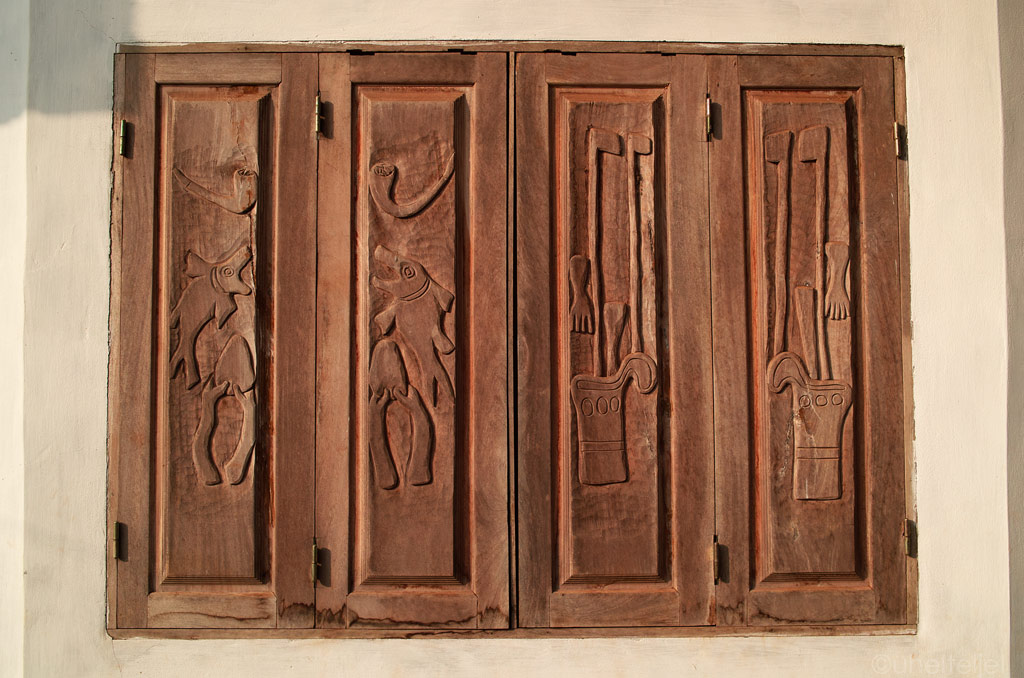
Some nice shutters carved out of wood.
So voodoo was founded together with the kingdom by the first king of Abomey, and this very first king had a palace built for himself. Since there were 12 kings during the period of existance of the kingdom, there were once 12 palaces in Abomey, and what is left of them is now a UNESCO world heritage site. Well, to be completely honest, those "palaces" do not quite look like palaces at all, but more like mud huts or stables, so we were not particularly impressed.
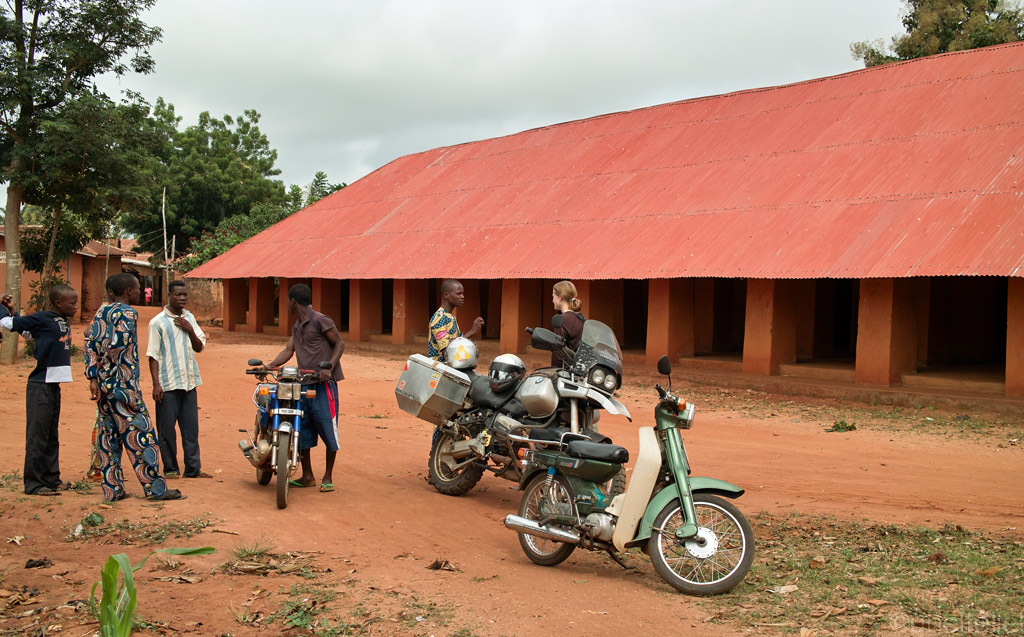
In front of a fetish temple.
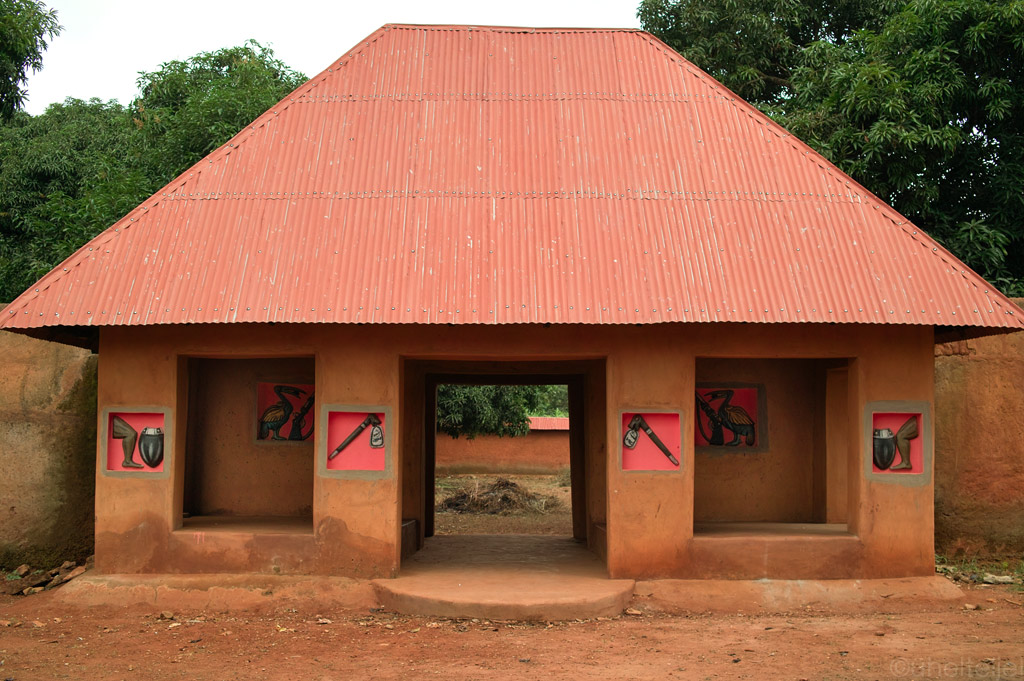
Entrance to one of the palaces - actually the best looking part of a palace.
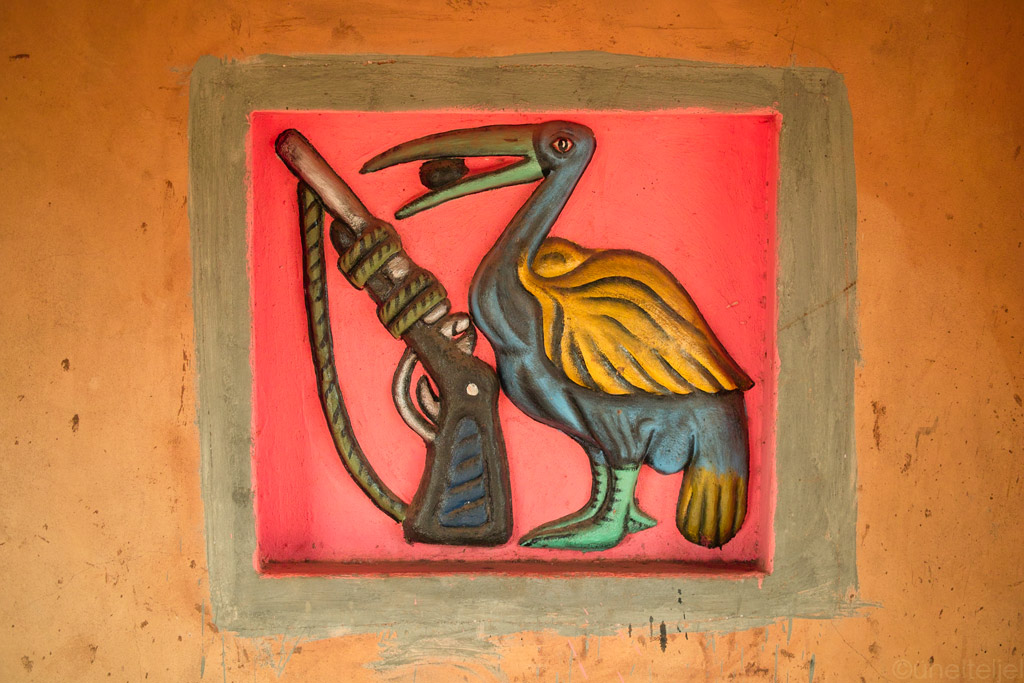
Each king had an emblem - this one has a bird swallowing the bullets, meaning no enemy can defeat the king.
From Abomey we headed to the coast to enjoy the ocean for the last time before heading further inland again. Interestingly, the overall atmosphere is decidedly tropical, even though it is the cold Atlantic ocean washing the shore. Here are some pics from Benin and Togo, the nature and the people.
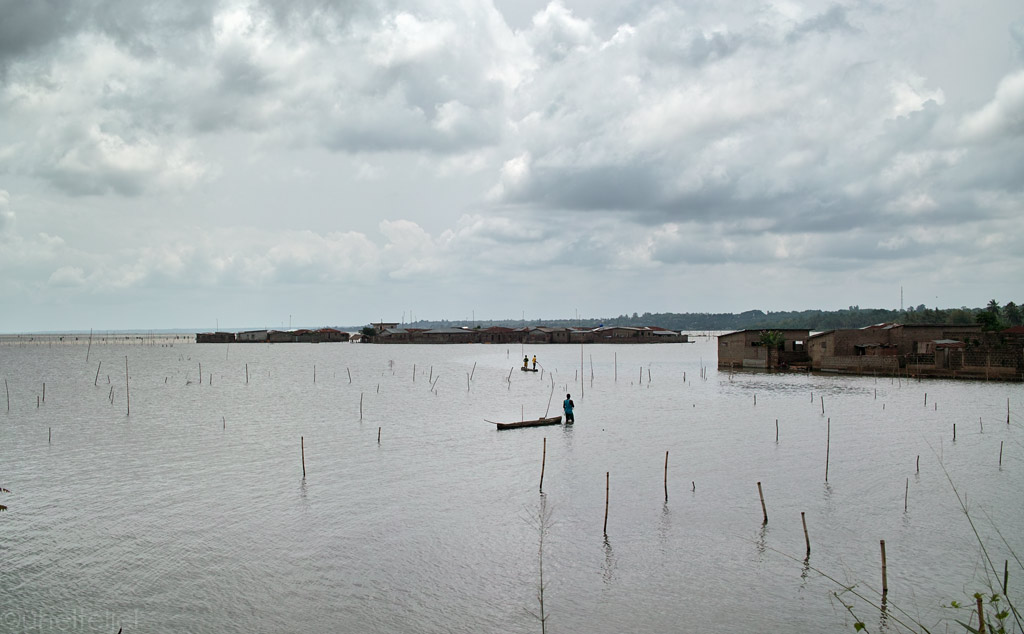
Fishermen on a lake - also some houses are built on the lake.
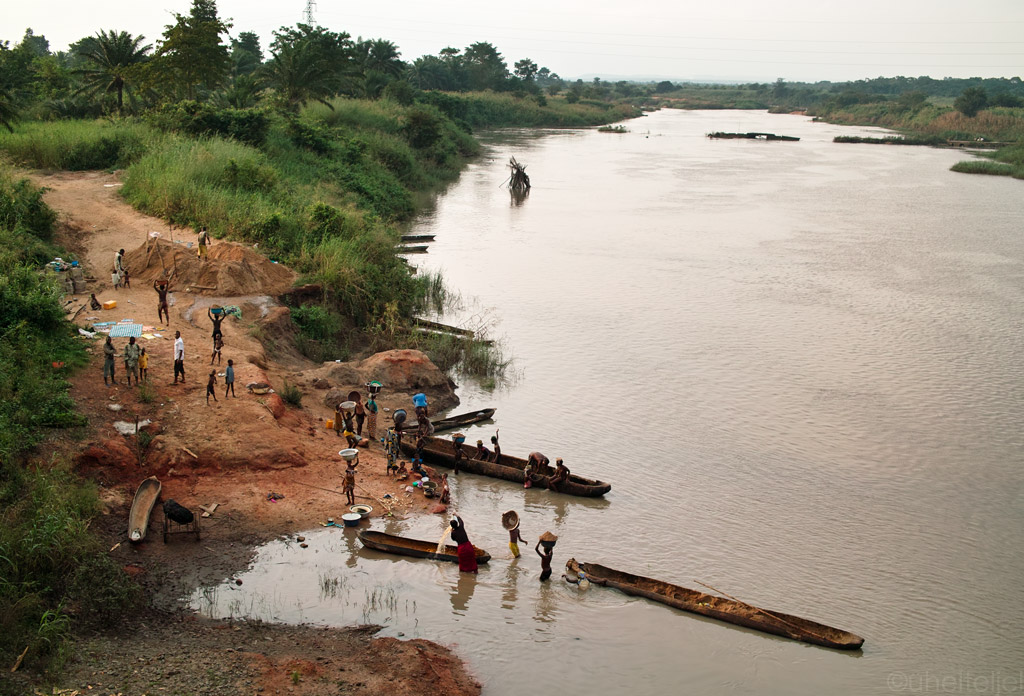
Life on a river in Benin.
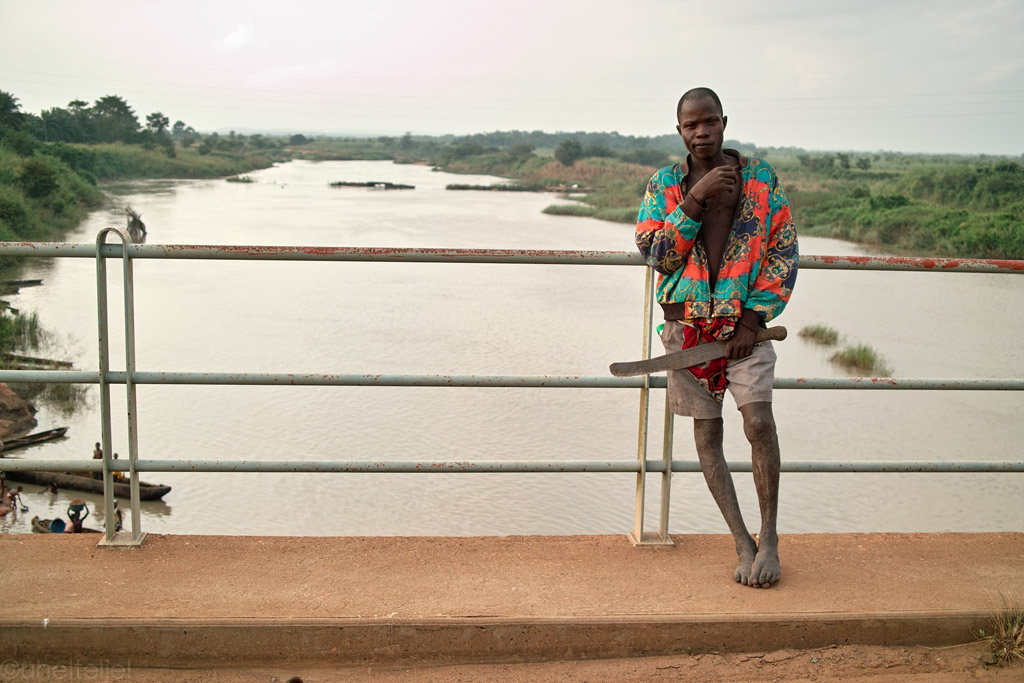
A man with a machete.
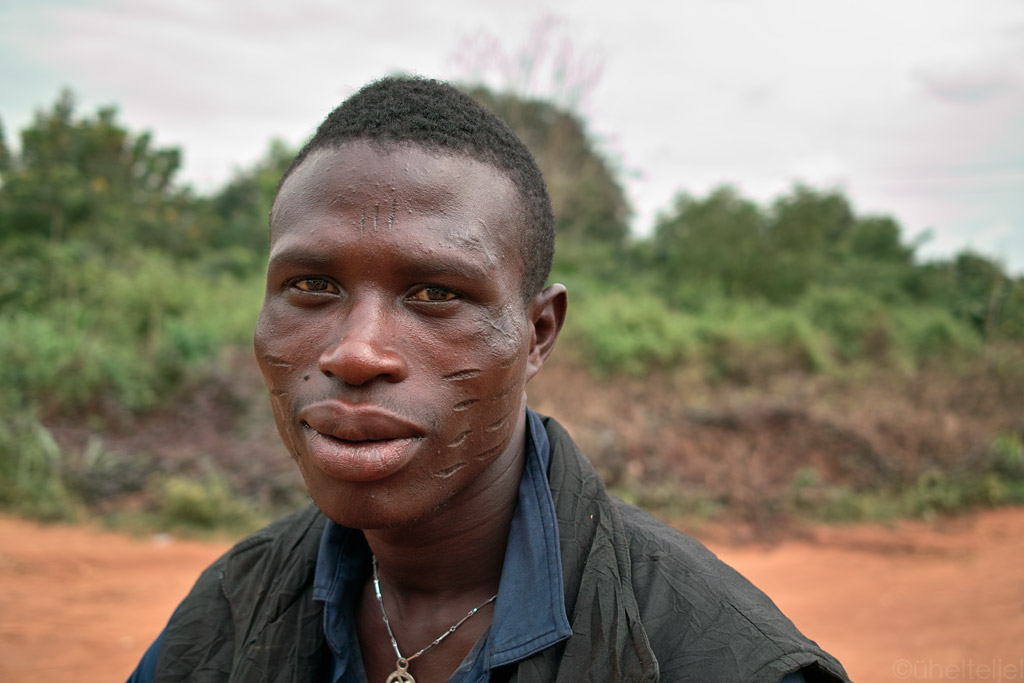
A man on the Nigeria-Benin border, the cuts on his face signifying the tribe he belongs to.
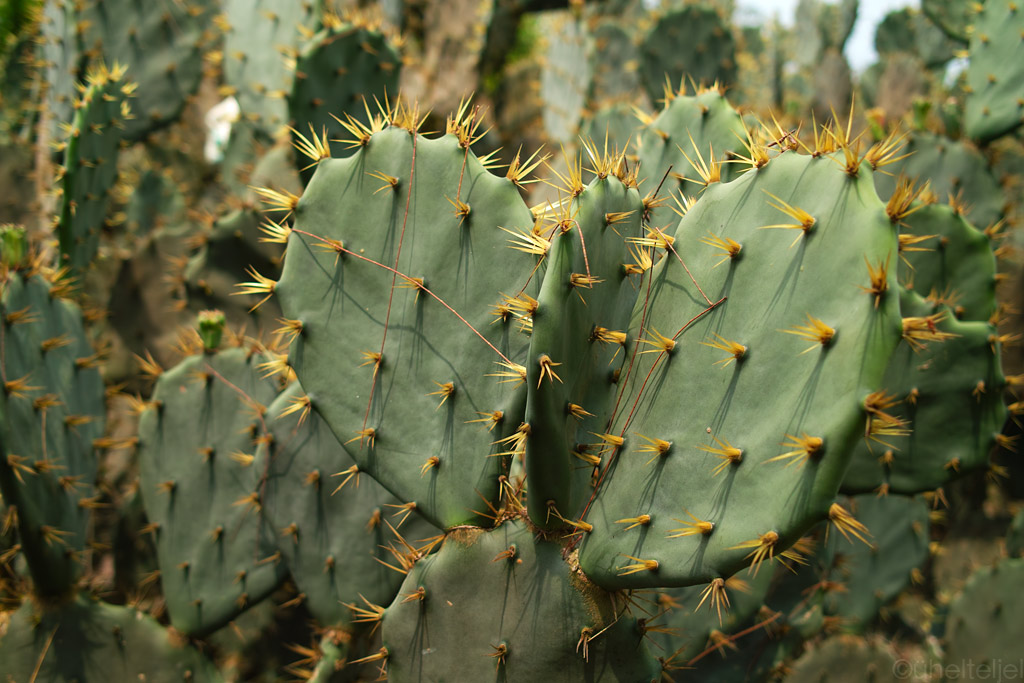
Cacti in Grand Popo, Benin.
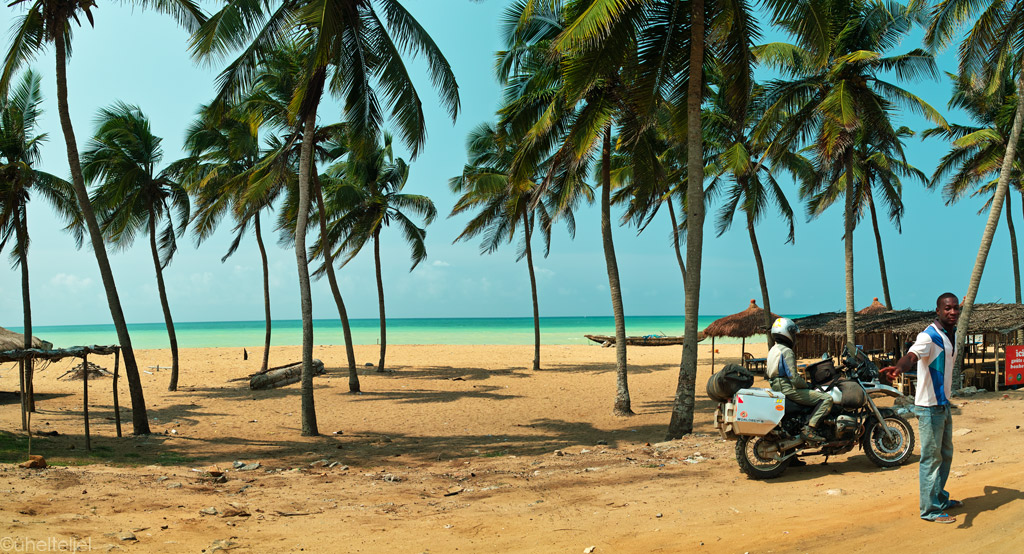
Palm trees on the beach in Togo.
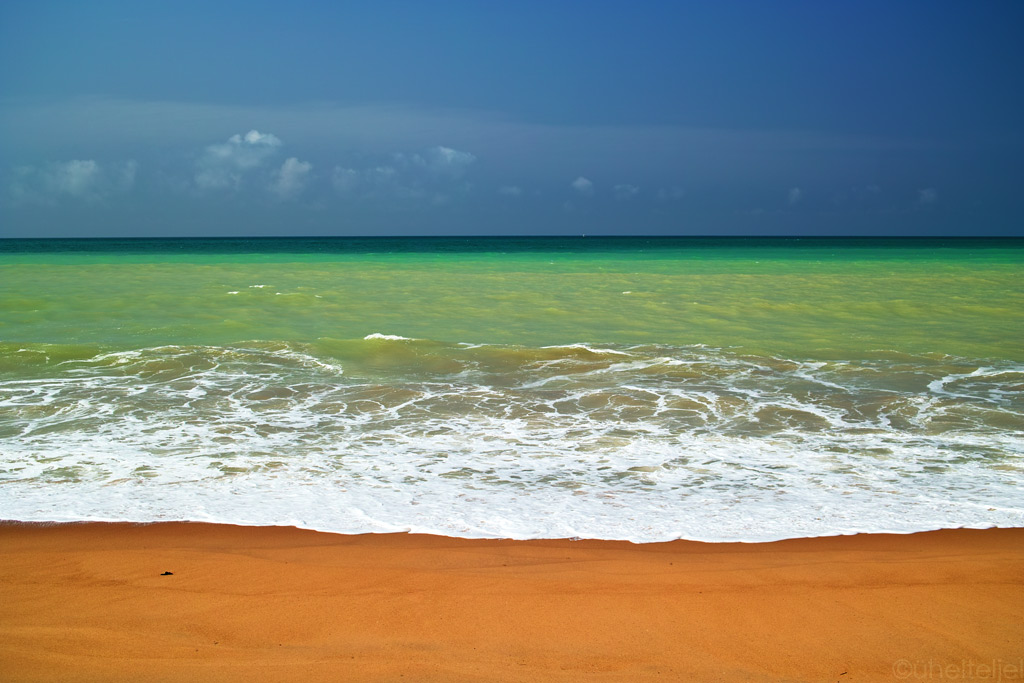
The Atlantic ocean.
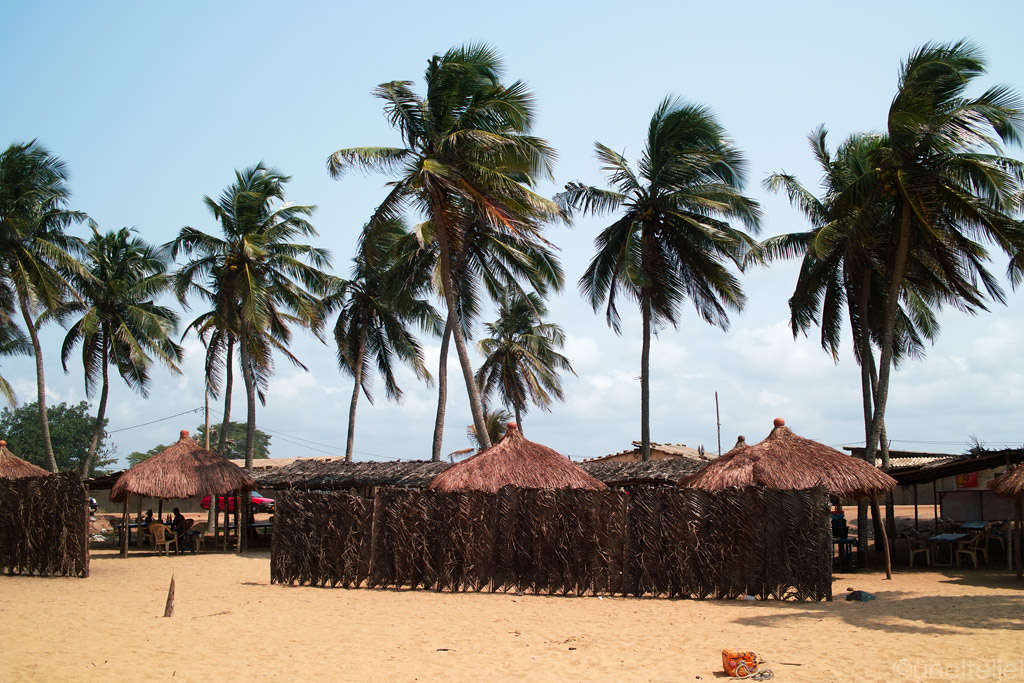
A Togolese fishing fillage.
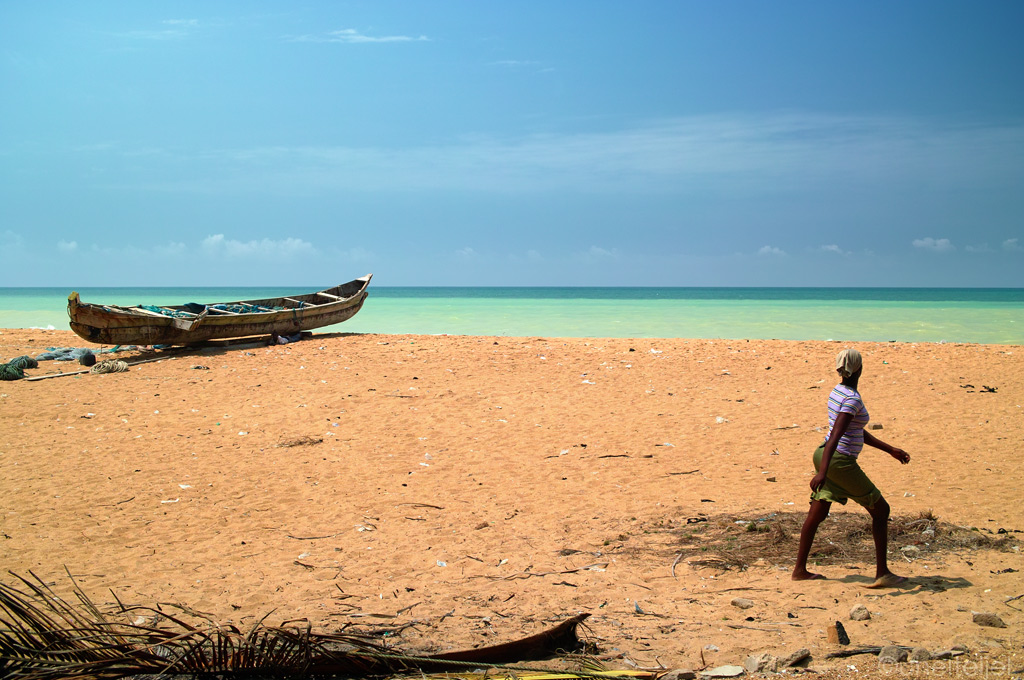
Atlantic coast in Togo.
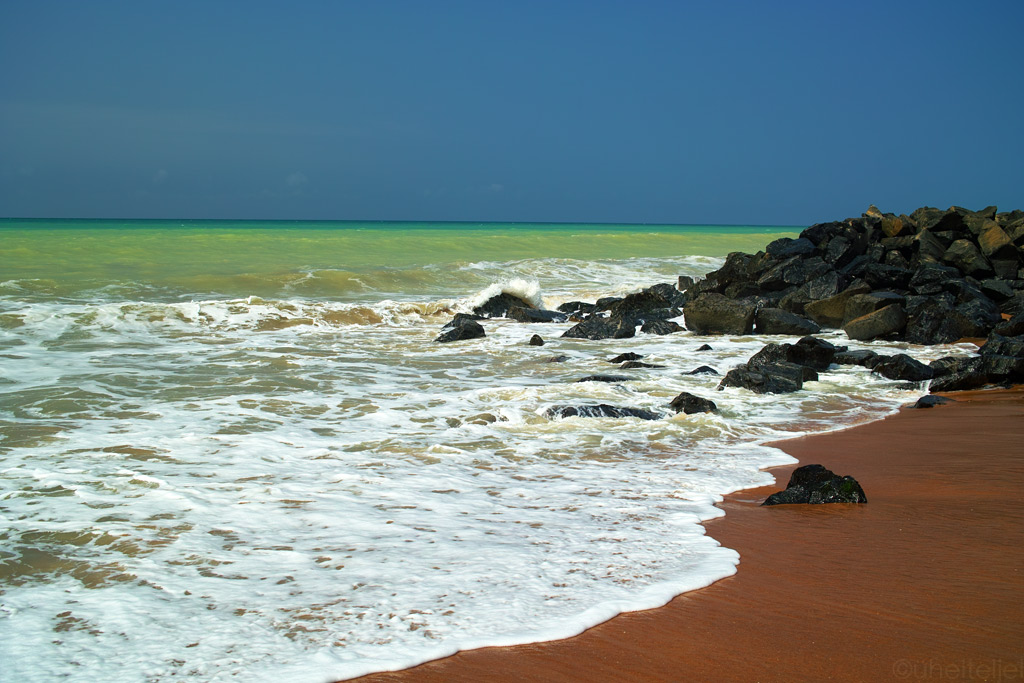
Turquoise.
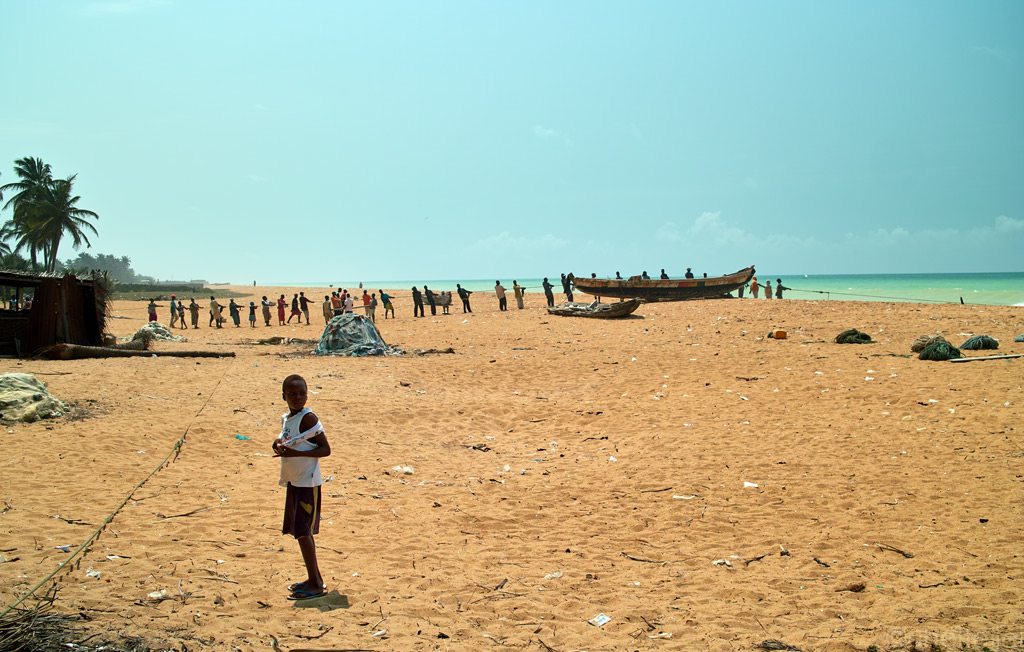
Hauling the fishing nets.
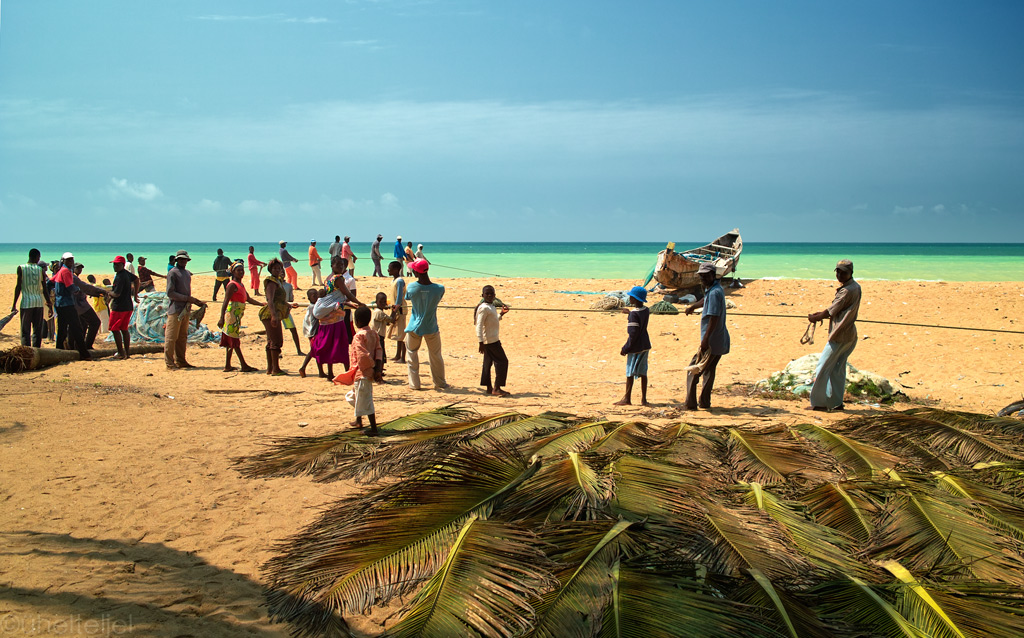
A community effort.
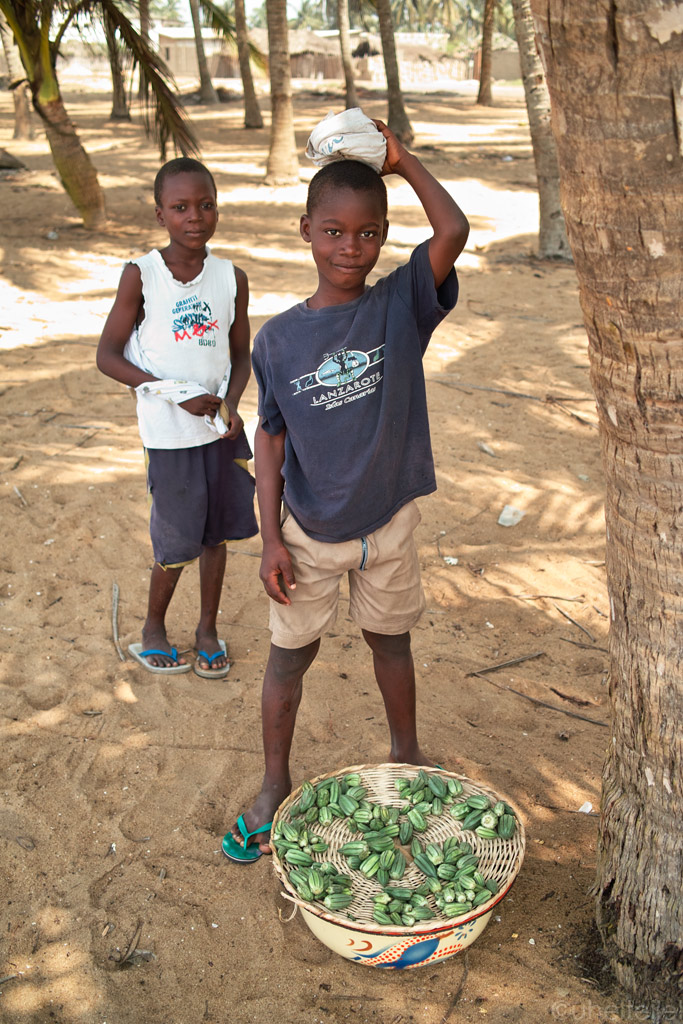
Young salesmen on the beach.
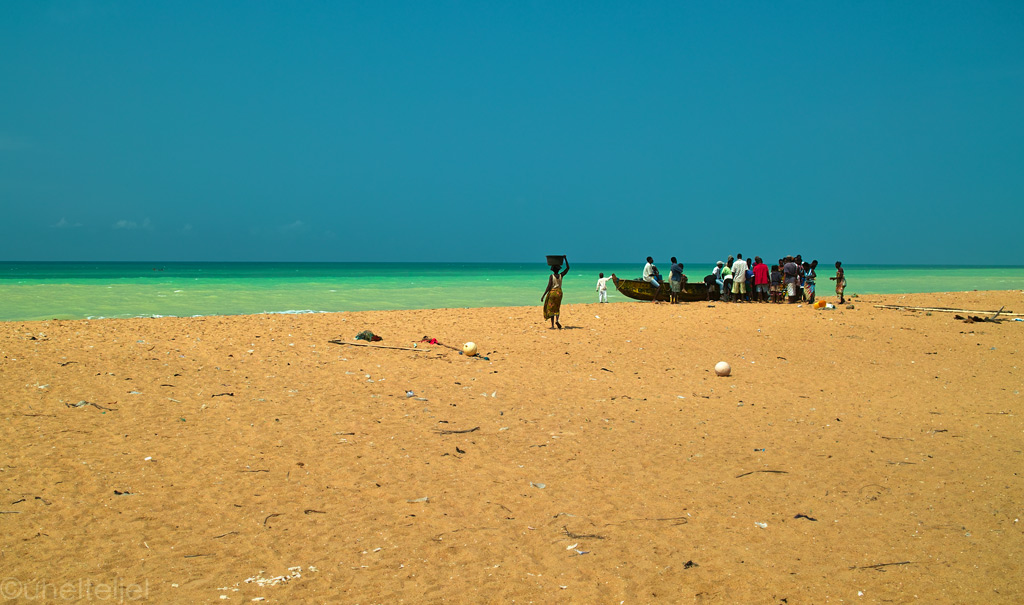
Bringing food to the fishermen.
Travelling around in Africa it is difficult to get around the subject of slavery. Although for us it may sound like some medieval thing, in Africa, slave trade has been the order of the day for centuries. The last country to abolish slavery was Mauritania, and it was only in the eighties. Which is also interesting is that although we are used to blame mainly the end consumer, or the slaveowner, the intermediary are actually no less guilty of offense. Who's the intermediary, you might ask? Well, those same glorious kingdoms such as the good-old Abomey for example, that mainly flourished because of the great incomes brought by the slave trade.
Fair enough, since it was agreed that slave trade was a bad thing, this understanding has been emphasized in many ways. The capital of Republic of the Congo, for example, got its name - Brazzaville - after an explorer by the name of de Brazza who fought against slavery. Also, a part of the West African coast stretching from Cameroon to Ghana has been named Slave Coast. Till today there are many reminders of the slave trading past in Ghana, centuries-old castles and forts lining the coast. The biggest slave trade centres of all West Africa used to be Cape Coast boasting a castle where slaves were being kept before embarking on a long journey across the ocean. Today, with its whitewashed walls, shining bright in the sunshine, as if trying to deny the grim past associated with it.
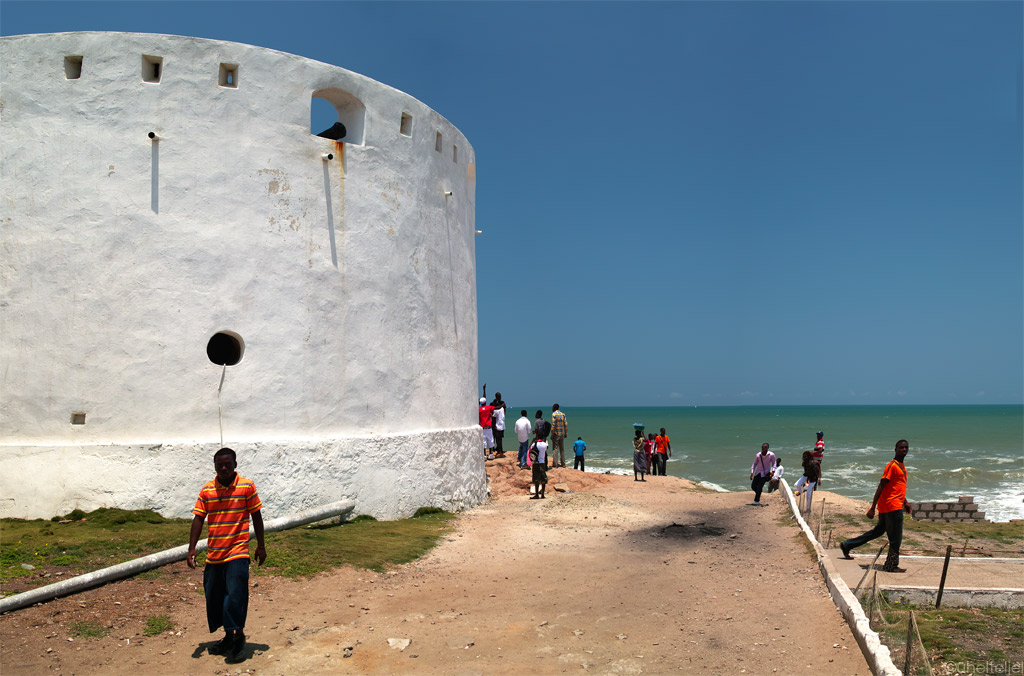
Part of the Cape Coast castle.
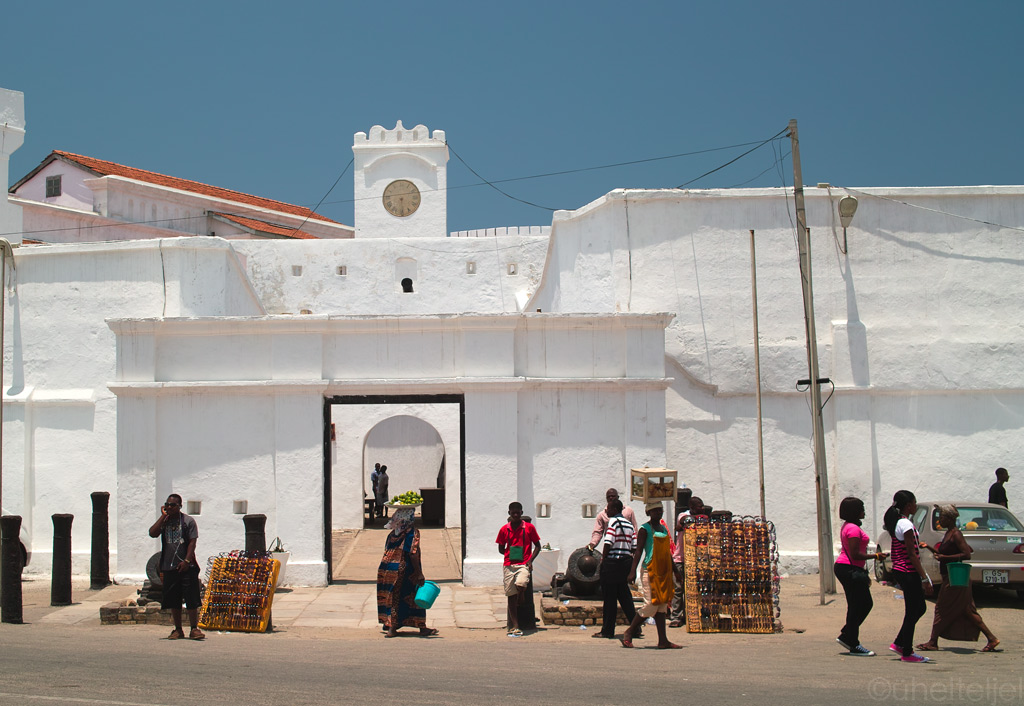
Busy life in front of it.
To be honest, so far all this slavery thing had escaped me (and thus there has not been much mention about it in our writings), but as we stumbled upon a dance and music show in the Ghanian night, there was a turning point - a moment where all things we had seen, heard and read about came together and started making sense. The music we were hearing had some Brazil in it, as well as some ultra modern rhythms, and the dance movements were just as if copied from that party we attended in Luanda, Angola. Surely, the slaves had taken along a piece of their culture and spread it around the world, but to actually witness the result was totally mindblowing. It was as if what we were experiencing had been exported from Angola, processed in Brazil and (since after the abolition of slavery many Brazilian slaves resettled on the West African coast, notably in Togo) finished in these areas here. And those modern rhythms - well, isn't it that most of the music that we are used to hear comes from the US? And isn't it that many of the musicians there are descendants of the people once relocated from Africa?
Listen for yourself:
...::: LISTEN Ghana's music and dance live I :::...
...::: LISTEN Ghana's music and dance live II :::...
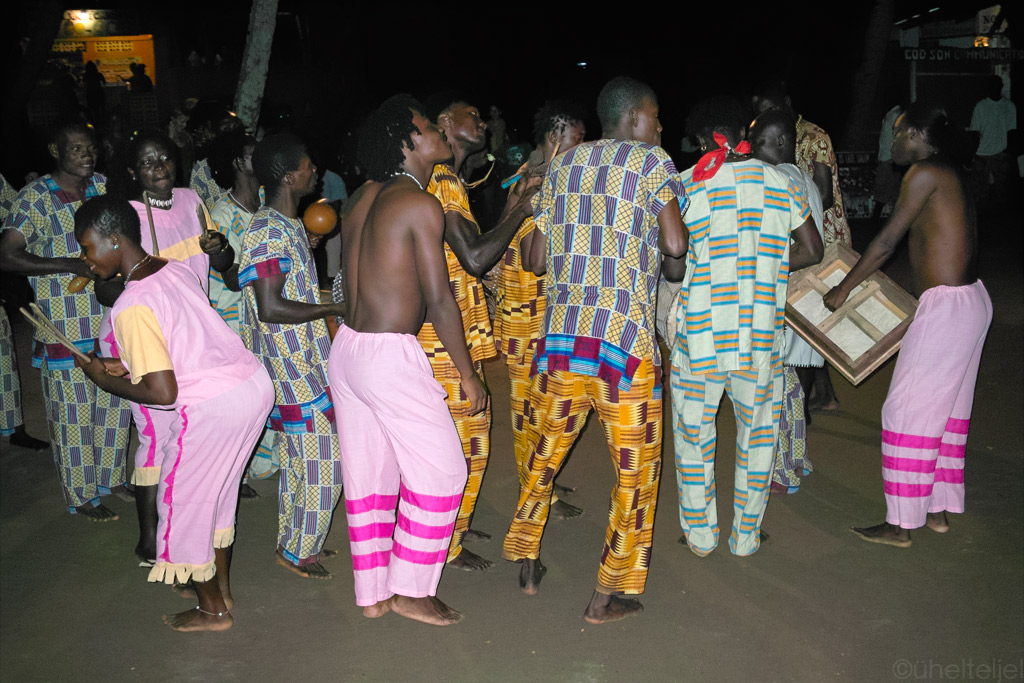
Singing and dancing.
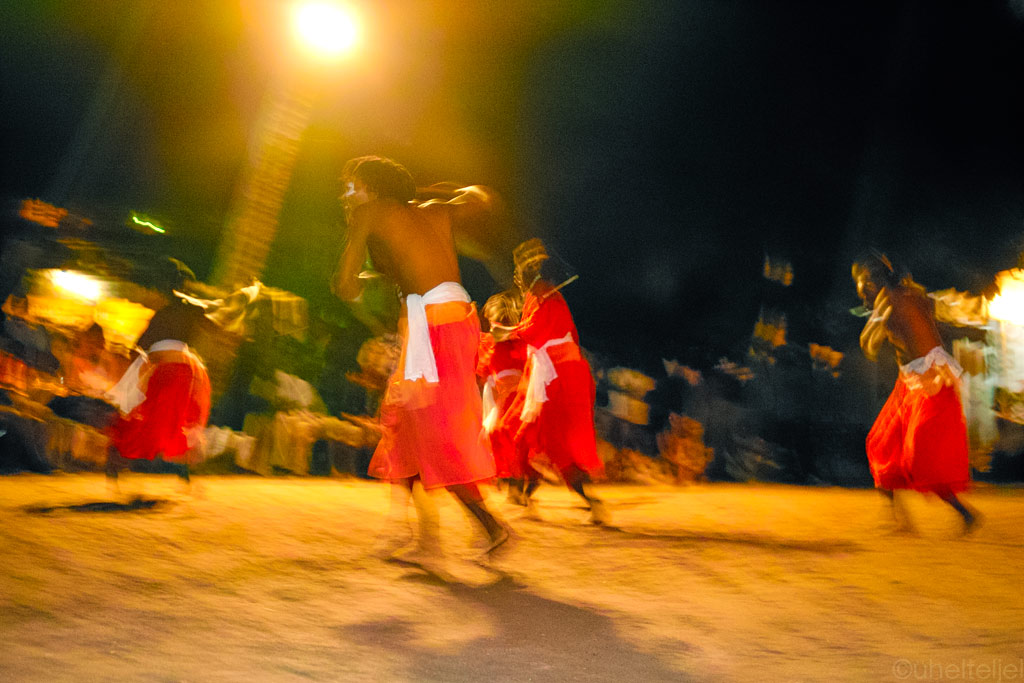
Action.
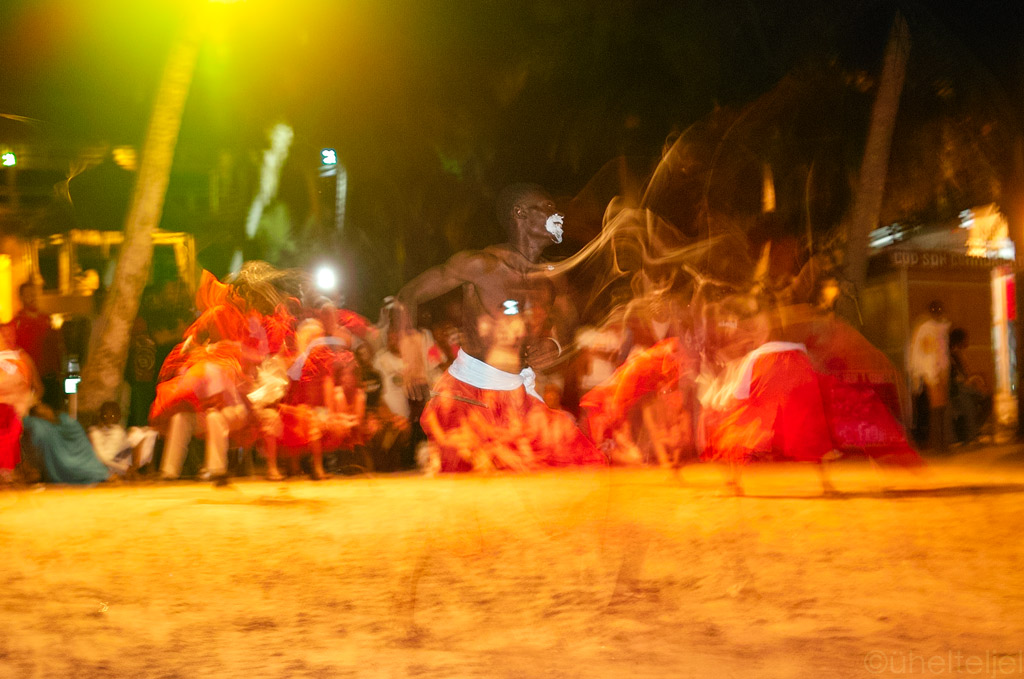
Bodies in motion, following the African rhythm.
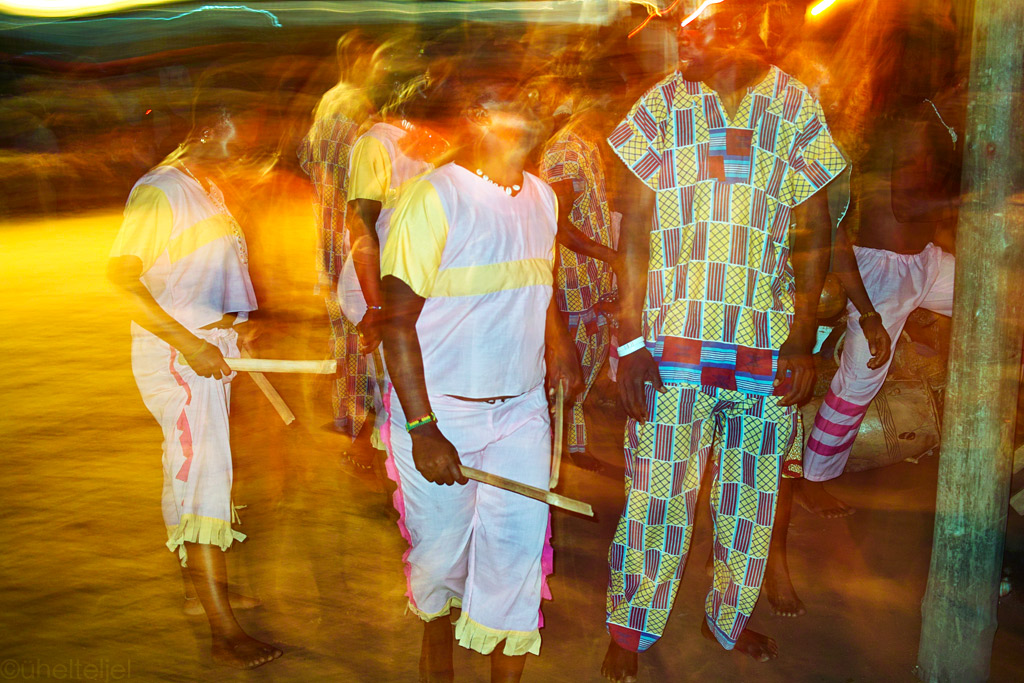
Rhythms in the night.
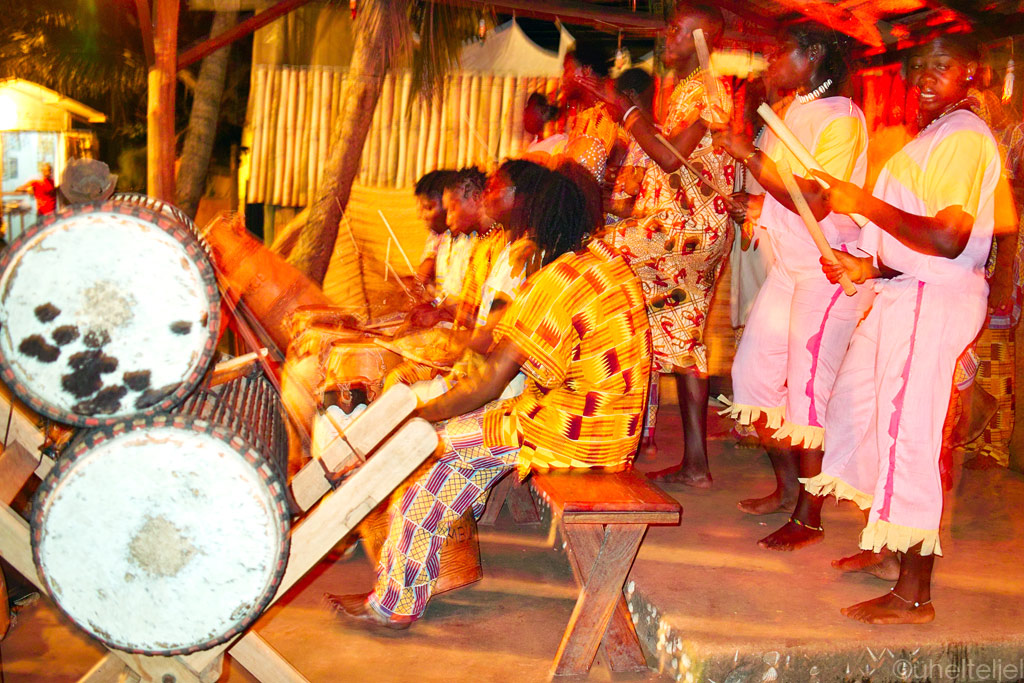
Percussions are the main ingredient.
OK, enough of philosophy, let us enjoy some of the simple beauty of the Ghanian coast with its charming fishing villages, sunsets and sunrises by the sea.
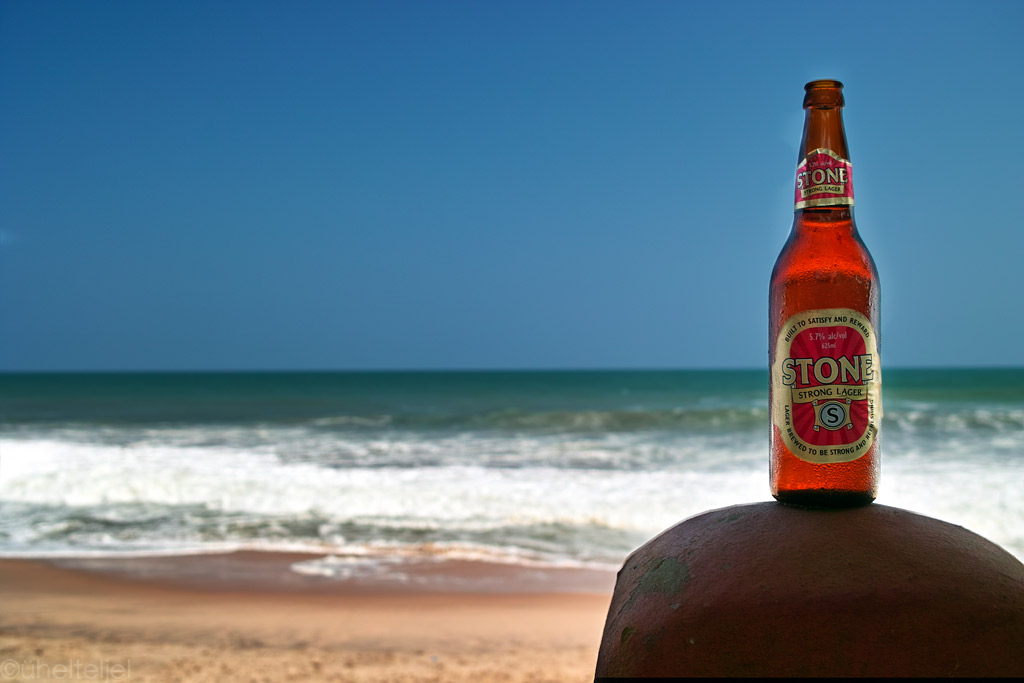
Stone.

Panorama of a fishing village in Ghana. (click to enlarge)

Hauling the fishing nets. (click to enlarge)
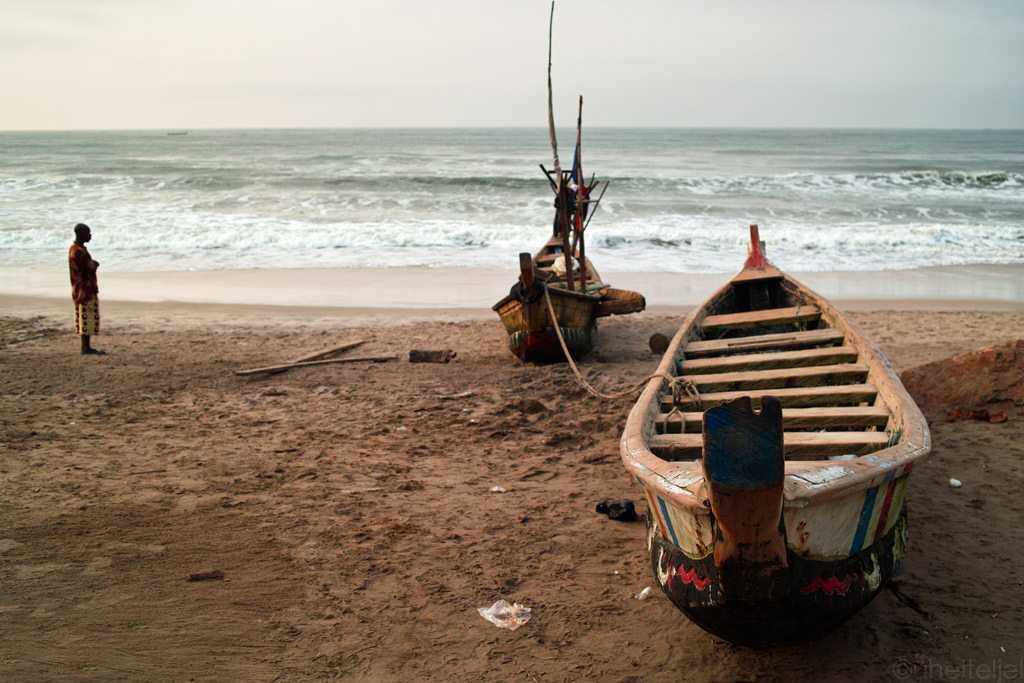
Boats on the beach.
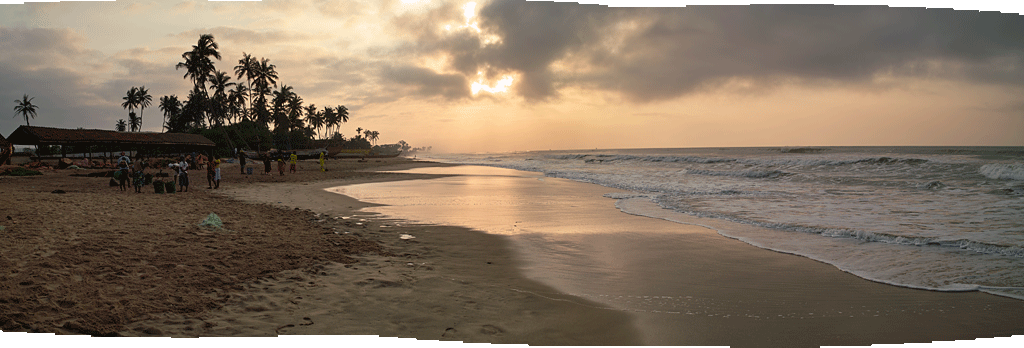
Sunrise near Accra. (click to enlarge)
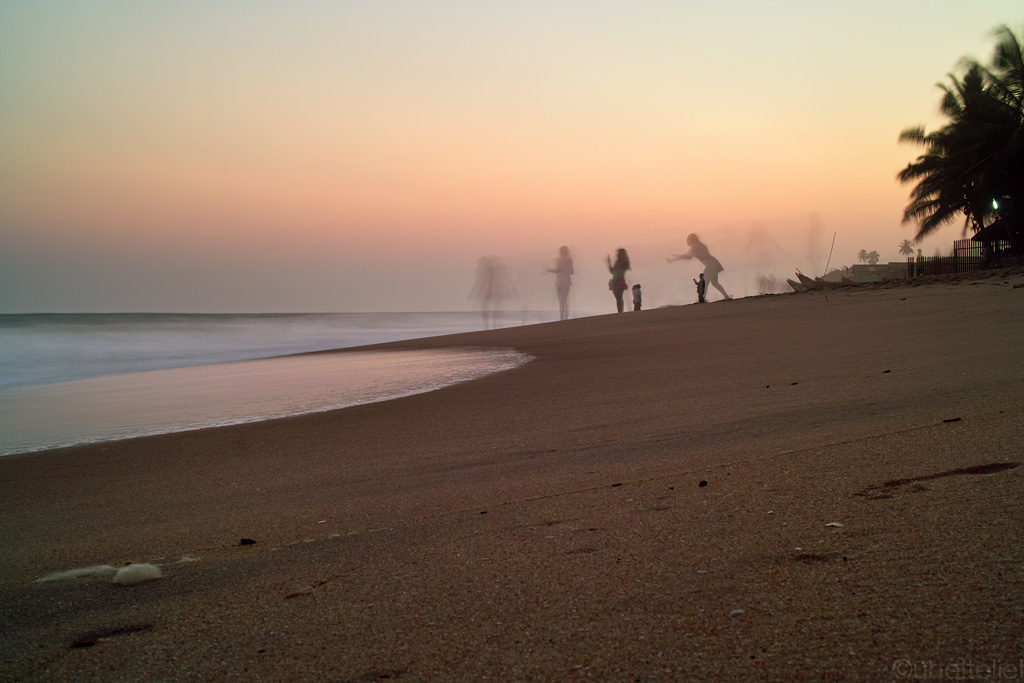
Local chicks posing for their Facebook photos.
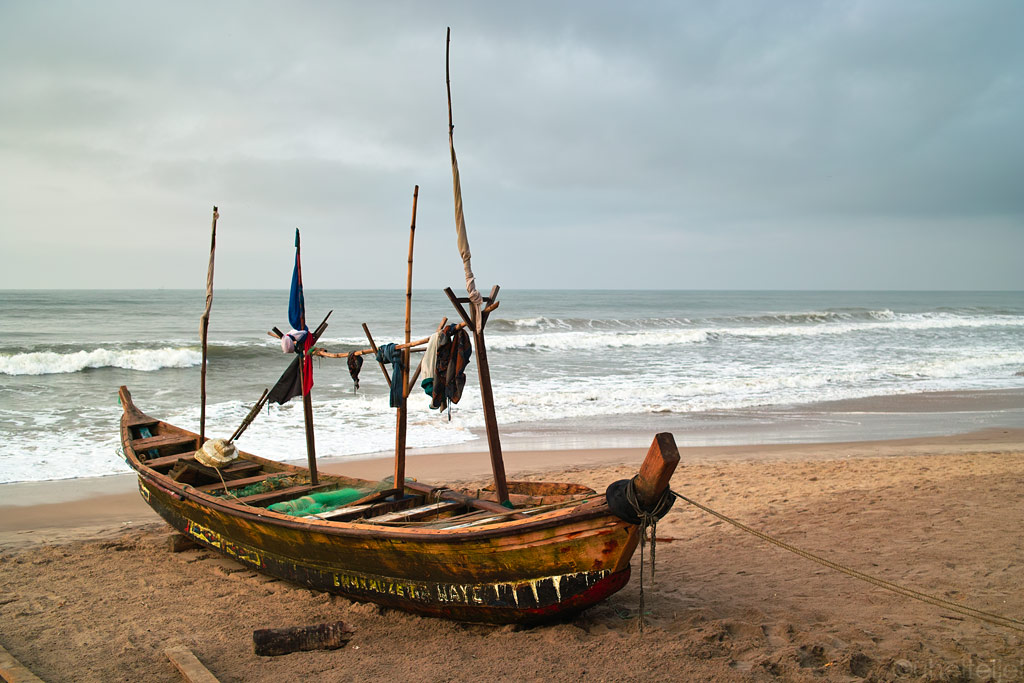
A colourful fishing boat.

A fishing village as seen from the beach. (click to enlarge)
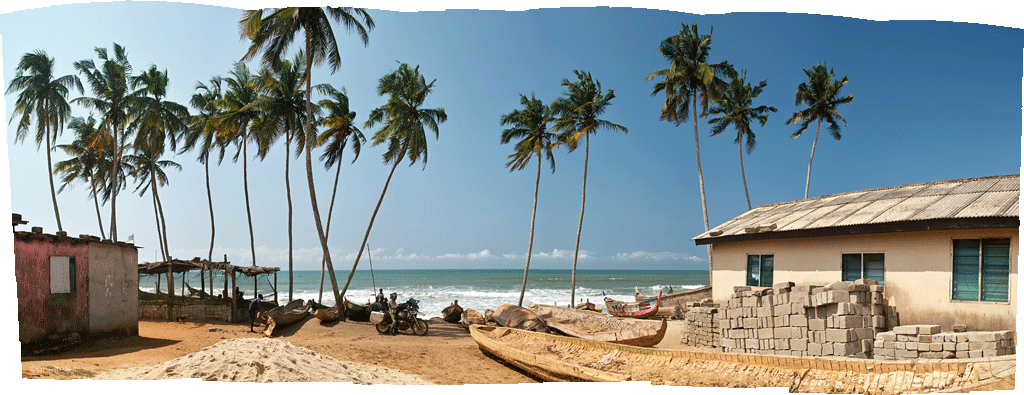
A local boat workshop - everything is done by hand. (click to enlarge)
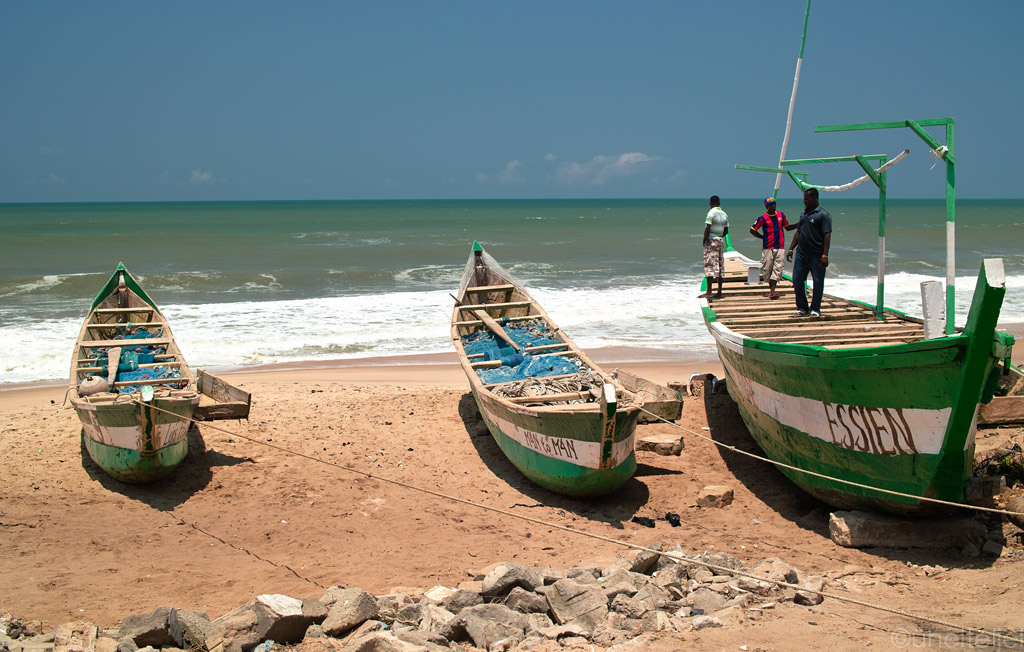
Inspecting and preparing the boats.
Once we had seen a part of the coast, the main attraction of Ghana, we headed on, towards north. Somehow, due to some inertia we still had in us since traversing Nigeria (you could say, at almost the speed of light), we soon found ourself at the border with Burkina Faso. It does seem and feel strange to whiz through a country so fast, but the rainy season means that those few attractions in the north of Ghana would have meant some muddy adventure, and we were not very keen on that since with our faulty rear suspension bush and running very low on budget we have to start making compromises on our route if we want to reach home on two wheels without selling or abandoning our bike.
A couple of pics from the way up noth:
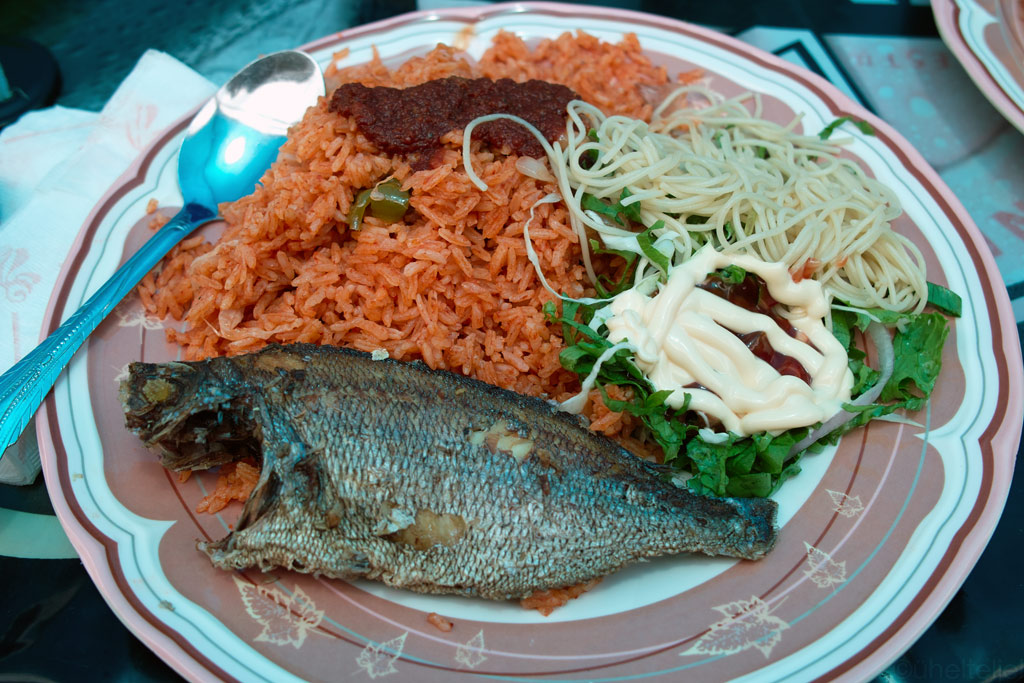
Local food - grilled fish with jollof rice and spaghetti.

Crossing the Black Volta. (click to enlarge)
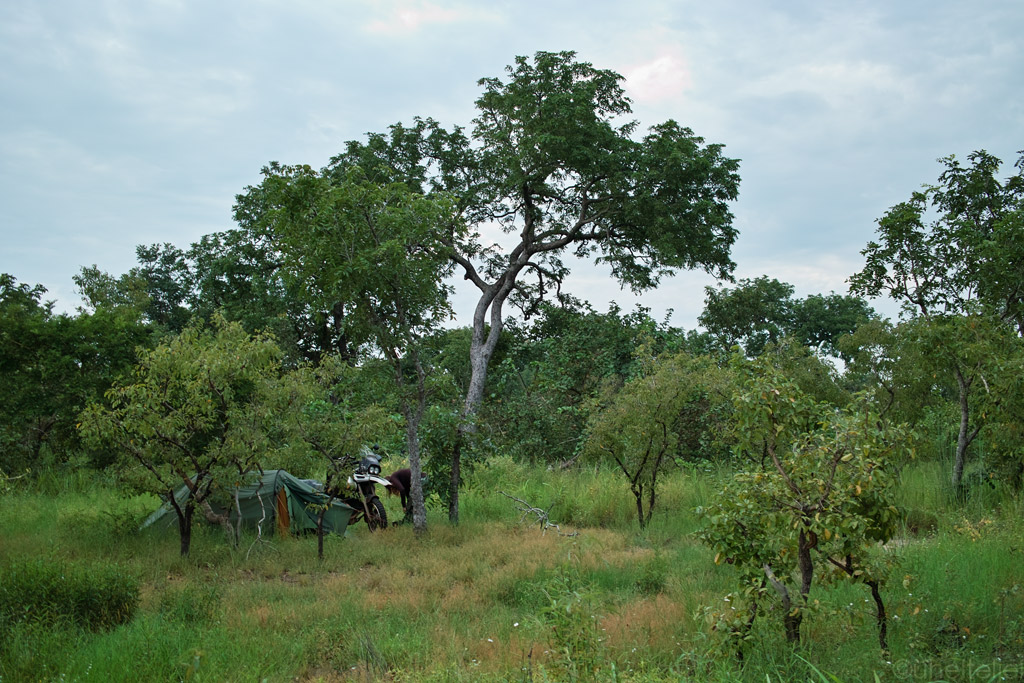
Camping in te bush. It is supposed to be a savanna area, but we had never seen a savanna so green. It must be the rainy season!
As a follow-up for the Congolese sand riding video, here's a few more sub-Saharan riding scenes that we believe, reflect quite adequately the real life experience on two wheels. Just add the hot and humid tropical climate, a riding suit permeated with sweat and the pungent aromas of the thirld world where sewage flows down the streets, and you get the answer to a few questions that may arise in your head at certain moments while watching the videos.
So, here they are, one from a dirt track in Cameroon, one from our ride through Benin City in Nigeria, and one from Lomé, the capital of Togo.
<iframe width="853" height="510" src="http://www.youtube.com/embed/nr-02HfZMNU" frameborder="0" allowfullscreen></iframe>
<iframe width="853" height="510" src="http://www.youtube.com/embed/ssP1PDm5cTs" frameborder="0" allowfullscreen></iframe>
<iframe width="853" height="510" src="http://www.youtube.com/embed/RQQIudmgRyo?rel=0" frameborder="0" allowfullscreen></iframe>
Hope you enjoyed the report,
Margus & Kariina
It must be voodoo. Reportedly it is from here that this religion was spread around the world, exported by the slaves to Brazil, Cuba and elsewhere. Today, in West Africa alone, tens of millions of people follow this seemingly weird religion that was founded here together with the famous kingdom of Abomey that existed from 1625 to 1892. It is not all about spells and human sacrifice, of course, but it does have some elements that would make us scorch our noses. Such as the use of fetishes - live or dead objects that are believed to have divine power and that are used in religious ceremonies and in everyday life to gain strength or protection against something, for example. While in Abomey, capital of the ancient kingdom, we went to see a fetish market where all sorts of dead birds and animals and their skulls were for sale, as well as some live specimen.
...::: LISTEN music from Benin I :::...
...::: LISTEN music from Benin II :::...
...::: LISTEN music from Benin III :::...
...::: LISTEN music from Benin IV :::...
...::: LISTEN music from Benin V :::...

Shopping for fetishes.

Fetishes for sale.

Birds are supposed to bring happiness.

Bisected rats and bats.

Snakes work for protection.

Predators.

Bats.

Toucan heads are hard to come by.

Leopard is one of the more powerful fetishes you can find.

Fetish seller with a live baby python - we could have bought it for 1 USD.
Also statues play an important role in voodoo religion, and we even saw one in the making - it is supposed to take one month to complete.

Still a long way to go.

More like it.

This is what it whould look like when finished.

Some nice shutters carved out of wood.
So voodoo was founded together with the kingdom by the first king of Abomey, and this very first king had a palace built for himself. Since there were 12 kings during the period of existance of the kingdom, there were once 12 palaces in Abomey, and what is left of them is now a UNESCO world heritage site. Well, to be completely honest, those "palaces" do not quite look like palaces at all, but more like mud huts or stables, so we were not particularly impressed.

In front of a fetish temple.

Entrance to one of the palaces - actually the best looking part of a palace.

Each king had an emblem - this one has a bird swallowing the bullets, meaning no enemy can defeat the king.
From Abomey we headed to the coast to enjoy the ocean for the last time before heading further inland again. Interestingly, the overall atmosphere is decidedly tropical, even though it is the cold Atlantic ocean washing the shore. Here are some pics from Benin and Togo, the nature and the people.

Fishermen on a lake - also some houses are built on the lake.

Life on a river in Benin.

A man with a machete.

A man on the Nigeria-Benin border, the cuts on his face signifying the tribe he belongs to.

Cacti in Grand Popo, Benin.

Palm trees on the beach in Togo.

The Atlantic ocean.

A Togolese fishing fillage.

Atlantic coast in Togo.

Turquoise.

Hauling the fishing nets.

A community effort.

Young salesmen on the beach.

Bringing food to the fishermen.
Travelling around in Africa it is difficult to get around the subject of slavery. Although for us it may sound like some medieval thing, in Africa, slave trade has been the order of the day for centuries. The last country to abolish slavery was Mauritania, and it was only in the eighties. Which is also interesting is that although we are used to blame mainly the end consumer, or the slaveowner, the intermediary are actually no less guilty of offense. Who's the intermediary, you might ask? Well, those same glorious kingdoms such as the good-old Abomey for example, that mainly flourished because of the great incomes brought by the slave trade.
Fair enough, since it was agreed that slave trade was a bad thing, this understanding has been emphasized in many ways. The capital of Republic of the Congo, for example, got its name - Brazzaville - after an explorer by the name of de Brazza who fought against slavery. Also, a part of the West African coast stretching from Cameroon to Ghana has been named Slave Coast. Till today there are many reminders of the slave trading past in Ghana, centuries-old castles and forts lining the coast. The biggest slave trade centres of all West Africa used to be Cape Coast boasting a castle where slaves were being kept before embarking on a long journey across the ocean. Today, with its whitewashed walls, shining bright in the sunshine, as if trying to deny the grim past associated with it.

Part of the Cape Coast castle.

Busy life in front of it.
To be honest, so far all this slavery thing had escaped me (and thus there has not been much mention about it in our writings), but as we stumbled upon a dance and music show in the Ghanian night, there was a turning point - a moment where all things we had seen, heard and read about came together and started making sense. The music we were hearing had some Brazil in it, as well as some ultra modern rhythms, and the dance movements were just as if copied from that party we attended in Luanda, Angola. Surely, the slaves had taken along a piece of their culture and spread it around the world, but to actually witness the result was totally mindblowing. It was as if what we were experiencing had been exported from Angola, processed in Brazil and (since after the abolition of slavery many Brazilian slaves resettled on the West African coast, notably in Togo) finished in these areas here. And those modern rhythms - well, isn't it that most of the music that we are used to hear comes from the US? And isn't it that many of the musicians there are descendants of the people once relocated from Africa?
Listen for yourself:
...::: LISTEN Ghana's music and dance live I :::...
...::: LISTEN Ghana's music and dance live II :::...

Singing and dancing.

Action.

Bodies in motion, following the African rhythm.

Rhythms in the night.

Percussions are the main ingredient.
OK, enough of philosophy, let us enjoy some of the simple beauty of the Ghanian coast with its charming fishing villages, sunsets and sunrises by the sea.

Stone.

Panorama of a fishing village in Ghana. (click to enlarge)

Hauling the fishing nets. (click to enlarge)

Boats on the beach.

Sunrise near Accra. (click to enlarge)

Local chicks posing for their Facebook photos.

A colourful fishing boat.

A fishing village as seen from the beach. (click to enlarge)

A local boat workshop - everything is done by hand. (click to enlarge)

Inspecting and preparing the boats.
Once we had seen a part of the coast, the main attraction of Ghana, we headed on, towards north. Somehow, due to some inertia we still had in us since traversing Nigeria (you could say, at almost the speed of light), we soon found ourself at the border with Burkina Faso. It does seem and feel strange to whiz through a country so fast, but the rainy season means that those few attractions in the north of Ghana would have meant some muddy adventure, and we were not very keen on that since with our faulty rear suspension bush and running very low on budget we have to start making compromises on our route if we want to reach home on two wheels without selling or abandoning our bike.
A couple of pics from the way up noth:

Local food - grilled fish with jollof rice and spaghetti.

Crossing the Black Volta. (click to enlarge)

Camping in te bush. It is supposed to be a savanna area, but we had never seen a savanna so green. It must be the rainy season!
As a follow-up for the Congolese sand riding video, here's a few more sub-Saharan riding scenes that we believe, reflect quite adequately the real life experience on two wheels. Just add the hot and humid tropical climate, a riding suit permeated with sweat and the pungent aromas of the thirld world where sewage flows down the streets, and you get the answer to a few questions that may arise in your head at certain moments while watching the videos.
So, here they are, one from a dirt track in Cameroon, one from our ride through Benin City in Nigeria, and one from Lomé, the capital of Togo.
<iframe width="853" height="510" src="http://www.youtube.com/embed/nr-02HfZMNU" frameborder="0" allowfullscreen></iframe>
<iframe width="853" height="510" src="http://www.youtube.com/embed/ssP1PDm5cTs" frameborder="0" allowfullscreen></iframe>
<iframe width="853" height="510" src="http://www.youtube.com/embed/RQQIudmgRyo?rel=0" frameborder="0" allowfullscreen></iframe>
Hope you enjoyed the report,
Margus & Kariina









